HTC STAR Smartphone User Manual StarTrek CWS Cingular3125 English manual indb
HTC Corporation Smartphone StarTrek CWS Cingular3125 English manual indb
HTC >
Contents
- 1. Users Manual Part 1
- 2. Users Manual Part 2
Users Manual Part 2
76 Getting Connected
To set up the phone as a Bluetooth modem
You can connect your phone to a computer through Bluetooth and use
the phone as a modem for the computer.
To learn how to set up the phone as a Bluetooth modem, see “Use the
phone as a Bluetooth modem” in this chapter.
Dial-up and connect to the Internet
Once the computer recognizes your phone as a modem, you can now
set up a dial-up connection. You will then be able to access the Internet
on your notebook using your phone.
To dial-up and connect to the Internet
1. On your notebook, click Start > Settings > Control Panel.
2. Double-click Network Connections.
3. Click File > New Connection.
4. In the New Connection Wizard, click Next.
5. Click Connect to the Internet, then click Next.
6. Select Set up my connection manually and then click Next.
7. Select Connect using a dial-up modem and then click Next.
8. Select the modem that you previously installed, then click Next.
9. Enter a descriptive name for your ISP, then click Next.
10. If you are connecting to the Internet via GPRS, enter the
telephone number as *99#. Otherwise, enter your ISP’s dial-up
phone number and then click Next.
11. Under Internet Account Information, you may not need to enter a
user name and password when using GPRS. Just click Next to
proceed.
12. Click Finish to exit the wizard.
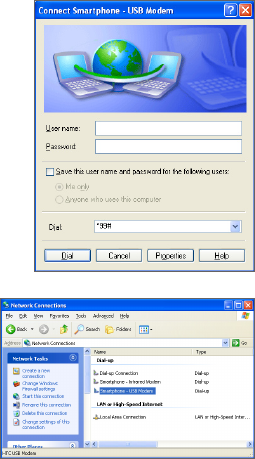
Getting Connected 77
13. The Connect dialog box
then opens. Click Dial to
dial up and connect to the
Internet.
Next time you want to
dial up again from your
computer, click Start >
Settings > Control Panel,
double-click Network
Connections, then
double-click the modem
connection.
Note To dial up to the Internet, you can also use the dialer program,
USBModem_Dialer.exe, which is included in the Getting Started Disc.
Follow the path: \OEM\APPS\Drivers\GSM USB Modem to find the file.
To end the modem session
• On the Wireless Modem screen, click Menu > Stop.
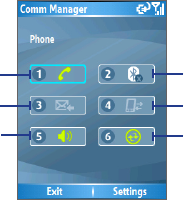
78 Getting Connected
5.4 Using Comm Manager
Comm Manager acts like a central switcher that lets you enable or
disable phone features as well as manage your data connections
easily.
To open Comm Manager:
• Click Start > Comm Manager.
1. Click to toggle between enabling and
disabling the phone.
2. Click to toggle between turning on
and off Bluetooth. Click Settings
> Bluetooth Settings to configure
Bluetooth on your phone. See “Using
Bluetooth” for details.
3. Click to toggle between automatically
receiving (as items arrive) and
manually retrieving Outlook e-mails.
For more information, see “To receive
e-mails and synchronize other
information instantly” in Chapter 3.
4. Click to disconnect active data
services (e.g. GPRS). You cannot
reconnect data services in Comm
Manager.
5. Click to toggle between turning on the
phone’s ringer and setting the phone
to vibration/mute mode.
6. Click to open ActiveSync so you can
synchronize the phone and computer.
For more information about the
configuration settings for ActiveSync,
see Chapter 3.
Comm Manager
3
1
5
2
4
6
Simply click the corresponding button to enable or disable a feature.
When you enable a feature, its button gets highlighted. The button
appears gray when the corresponding feature is disabled.
Getting Connected 79
5.5 Using Bluetooth
Bluetooth is a short-range wireless communications technology.
Devices with Bluetooth capabilities can exchange information over a
distance of about 8 meters without requiring a physical connection. You
can even beam information to a device in a different room, as long as it
is within the Bluetooth signal coverage range.
Bluetooth can be used in the following ways:
• Beam information, such as files, appointments, tasks and contact
cards between devices that have Bluetooth capabilities.
• Synchronize information between your phone and computer via
Bluetooth.
• Use a Bluetooth service. Once you connect your phone to
another device or computer using Bluetooth, you can locate and
use any of the services available on that device.
• Use your phone as a Bluetooth modem for a computer.
Bluetooth modes
Bluetooth on your phone operates in three different modes:
1. On. Bluetooth is turned on. Your phone can detect other
Bluetooth-enabled devices, but not vice versa.
2. Off. Bluetooth is turned off. In this mode, you can neither send
nor receive information using Bluetooth. You might want to turn
off the radio at times to conserve battery power, or in situations
where radio use is prohibited, such as onboard an aircraft and in
hospitals.
3. Discoverable. Bluetooth is turned on and all other Bluetooth-
enabled devices within a range of 5 meters can detect your
phone.
Note By default, Bluetooth is turned off. If you turn it on, and then turn off your
phone, Bluetooth also turns off. When you turn on your phone again,
Bluetooth automatically turns on.
80 Getting Connected
To turn Bluetooth on or off on your phone
You can enable Bluetooth by clicking the On/Off switch in Comm
Manager. You can also do the following:
1. On the Home screen, click Start > Settings > Connections >
Bluetooth.
2. In Bluetooth, select On.
3. Click Done.
4. To turn off Bluetooth capabilities on your phone, in Bluetooth,
select Off.
To make your phone discoverable
1. On the Home screen, click Start > Settings > Connections >
Bluetooth.
2. In Bluetooth, select Discoverable.
3. Enter a Bluetooth device name for your phone. This will be the
device name that will be shown on another Bluetooth-enabled
device when it searches and detects your phone.
4. Click Done.
Note Selecting the Discoverable option on the Bluetooth screen also turns
on Bluetooth.
Bluetooth partnerships
A Bluetooth partnership is a relationship that you create between your
phone and another Bluetooth-enabled device in order to exchange
information in a secure manner.
Creating a partnership between two devices involves entering the
same personal identification number (PIN) on both devices, and this
is a one-time process. Once a partnership is created, the devices can
recognize the partnership and exchange information without entering
a PIN again. Make sure the two devices are within 8 meters, and that
Bluetooth is turned on and in discoverable mode.
Getting Connected 81
To create a Bluetooth partnership
1. On the Home screen, click Start > Settings > Connections >
Bluetooth.
2. Click Menu > Devices.
3. Click Menu > New to search for a new device.
Your phone searches for other Bluetooth-enabled devices and
lists them.
4. Select the desired device name in the list.
5. Click Next.
6. Enter a passkey (of between 1 and 16 characters) to establish a
secure connection, then click Next.
7. Wait for the paired device to accept the partnership:
• If you are creating a Bluetooth partnership between your
phone and another Bluetooth-enabled Pocket PC or phone,
the receiving party needs to enter the same passkey that you
specified.
• If you are creating a Bluetooth partnership between your
phone and computer, a balloon message will appear at the
bottom-right of the computer screen, prompting your computer
to accept the partnership. Click the message and then enter
the passkey.
8. On your phone, a message will appear, indicating that your phone
has connected with the paired device. Click OK.
9. The name of the paired device is then displayed. You may edit
and enter a new name for that device, then click Next.
10. Select the check boxes of services that you want to use from the
paired device.
11. Click Done.
82 Getting Connected
To accept a Bluetooth partnership
1. Ensure that Bluetooth is turned on and in discoverable mode.
2. Click Yes when prompted to establish a partnership with another
device.
3. Enter a passkey (the same passkey that is entered on the device
requesting the partnership) to establish a secure connection.
The passkey must be between 1 and 16 characters long.
4. Click Next.
5. A message will appear indicating that your phone has connected
with the paired device. Click OK.
6. The name of the paired device is then displayed. You may edit
and enter a new name for that device. Then click Next.
7. Select the check boxes of services that you want to use from the
paired device.
8. Click Done. You can now exchange information with another
device.
To change the display name of a Bluetooth device
1. On the Home screen, click Start > Settings > Connections >
Bluetooth.
2. Click Menu > Devices.
3. Select a detected Bluetooth device.
4. Click Menu > Edit.
5. Enter a new display name for the Bluetooth device, then click
Next.
6. Click Done.
To delete a Bluetooth partnership
1. On the Home screen, click Start > Settings > Connections >
Bluetooth.
2. Click Menu > Devices.
3. Select a Bluetooth device.
4. Click Menu > Delete.
5. Click Done.
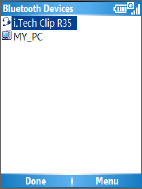
Getting Connected 83
Connect a Bluetooth handsfree or stereo headset
For handsfree phone conversations, you can use a Bluetooth
handsfree headset such as a car kit with your phone.
Your phone also supports A2DP (Advanced Audio Distribution Profile)
which is for stereo audio over Bluetooth. This means that you can
use a Bluetooth stereo headset with your phone for handsfree phone
conversations as well as for listening to stereo music. Make sure that
your stereo headset also supports A2DP.
Just like when connecting to any Bluetooth device, you also need to
enter a passkey when connecting to a Bluetooth handsfree or stereo
headset. The passkey is fixed and cannot be changed on a Bluetooth
headset. Before you connect it with your phone, check for the proper
passkey in the manufacturer’s documentation.
To connect a Bluetooth handsfree or stereo headset
1. Make sure that both your phone and the Bluetooth headset
are turned on and within close range, and that the headset is
discoverable. Refer to the manufacturer’s documentation to find
out how to set the headset in discoverable mode.
2. On the Home screen, click Start >
Settings > Connections.
3. Click Bluetooth > Menu > Devices.
4. Click Menu > New. Your device
searches for other Bluetooth-enabled
devices and displays them in the list.
5. Select the name of the headset and
click Add.
6. In Passkey, enter the alphanumeric
passkey for the Bluetooth headset,
then click Next.
7. Select the check box for the hands-free service and click Finish.
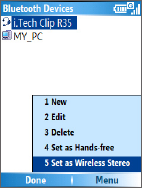
84 Getting Connected
Note If the Bluetooth headset becomes disconnected, turn the headset on
and repeat steps 1 to 3 above. Select the headset and click Menu > Set
as Hands-free or Set as Wireless Stereo.
Beam information using Bluetooth
You can beam information, such as contacts, calendar items and
tasks, as well as files from your phone to your computer or to another
Bluetooth-enabled device.
Note If your computer does not have built-in Bluetooth capabilities, you need
to connect and use a Bluetooth adapter or dongle on your computer.
To beam information from your phone to a computer
1. Set Bluetooth on your phone to discoverable mode. For
information about this, see “To make your phone discoverable”.
2. Next, set Bluetooth on your computer to discoverable mode,
create a Bluetooth partnership, then enable your computer to
receive Bluetooth beams.
If your computer has Windows XP SP2 and your computer’s built-
in or external Bluetooth adapter is supported by Windows XP
SP2, do the following steps:
• On your computer, open Bluetooth Devices from the Control
Panel and then click the Options tab.
• Select the Turn discovery on and the Allow Bluetooth
devices to connect to this computer options.
Getting Connected 85
• Create a Bluetooth partnership between your phone and your
computer. For information about creating a partnership, see
“Bluetooth partnerships”.
• In the Options tab of Bluetooth Devices, select Show the
Bluetooth icon in the notification area.
• To allow your computer to receive Bluetooth beams, right-
click the Bluetooth icon at the bottom-right of your computer
screen. A menu then opens. Click Receive a File.
If the Bluetooth adapter on your computer is installed by a third-
party provided driver, do the following steps:
• Open the Bluetooth software that comes with the Bluetooth
adapter. This software varies by manufacturer, but in most
cases, you will find a Bluetooth Configuration utility which
you can open from the Control Panel.
• Click the Accessibility tab in the Bluetooth Configuration
dialog box, then select Let other Bluetooth devices to
discover this computer.
• Create a Bluetooth partnership between your device and
computer. For information about creating a partnership, see
“Bluetooth partnerships”.
• Refer to the Bluetooth adapter’s documentation for
instructions on how to allow your computer to receive
Bluetooth beams.
3. Now you’re ready to beam. On your phone, select an item to
beam. The item can be an appointment in your calendar, a task, a
contact card or a file.
4. Click Menu > Beam [type of item].
5. Select the device name to which you want to beam.
6. Click Beam.
7. If you beam a calendar, task or contact item to your computer and
it is not automatically added to Outlook, click File > Import and
Export to import it to Microsoft Outlook on your computer.
86 Getting Connected
To beam information to a Bluetooth-enabled device such as another
phone, create a Bluetooth partnership and then do steps 3 to 6 in the
above procedure.
Notes
• If the computer or device you want to beam to cannot be detected by
your phone, make sure that it is turned on, discoverable and within
close range (8 meters) of your phone.
• The default folder on your computer where beamed items are stored
may be
C:\Documents and Settings\your_username\My Documents.
• If your computer’s Bluetooth adapter is installed using a third-party
provided driver, the folder location where it stores beamed items
will be indicated in the Information Exchange tab of the Bluetooth
Configuration utility.
Use the phone as a Bluetooth modem
You can connect your phone to a notebook or desktop computer
through Bluetooth and use the phone as a modem for the computer.
To connect your phone to the computer through Bluetooth, you need a
Bluetooth radio adapter (or USB Bluetooth dongle) for your computer.
To set up a Bluetooth connection between the phone and the
computer (in Windows XP SP2)
1. On the phone, turn on Bluetooth and set it to discoverable mode.
2. Connect a Bluetooth radio adapter to your computer. (Refer to
the manufacturer’s documentation for details on how to install.)
After a Bluetooth radio adapter is installed on your computer, the
Bluetooth Devices icon appears on the Control Panel and System
Tray.
3. In the Bluetooth Devices window, click Add.
4. The Add Bluetooth Device Wizard opens. Select the My device
is set up and ready to be found check box, then click Next.
5. The wizard then detects your phone as a new device and
displays its name in the dialog box. Select the device name, then
click Next.
Getting Connected 87
6. Select Let me choose my own passkey, then enter a passkey
(between 1 and 16 digits) that serves as an identification number
for establishing a secure connection between the phone and the
computer. Click Next.
7. A confirmation message then appears on your phone. Click Yes
to accept the connection. Enter the same passkey, then click
Next.
8. On the computer, click Finish to exit the wizard.
9. On the phone’s Device Added screen, click OK.
10. Enter a display name for the computer, then click Next.
11. On the Services screen, click Done.
12. On the Home screen of your phone, click Start > Accessories >
Wireless Modem.
13. Select Bluetooth as the Connection type.
14. To use your phone as a GPRS modem, set the Access point
name (APN). To set, click Menu > APN Setting and enter the
access point name.
15. On your notebook, disable ActiveSync.
Note To disable ActiveSync on your computer, click File > Connection
Settings and then clear Allow connections to one of the following.
16. Click Menu > Start on your phone.
After successfully connecting your phone to the computer via
Bluetooth, the next thing to do is to add your phone as a Bluetooth
modem to your computer.
To add the phone as a Bluetooth modem
1. On the computer, click Start > Control Panel > Phone and
Modem Options.
2. Click the Modems tab. Check if there is a Bluetooth modem,
“Generic Bluetooth Modem” or “Standard Modem over Bluetooth
Link” listed. If there is, skip to step 6.
3. If there is no Bluetooth modem listed in the Modems tab, click
Add.
88 Getting Connected
4. In the Add Hardware Wizard, click Next.
5. In the Select Bluetooth Device screen, select the phone name
and then click OK.
6. In the Modems tab, select the Bluetooth modem listed and then
click Properties.
7. Click the Advanced tab, then in the Extra initialization
commands text box, enter:
AT+CGDCONT=1,“IP”,“APN”
where APN is the access point name provided by your mobile
network operator to give you access to the Internet. Then click
OK.
8. Click OK to exit the Phone and Modem Options.
Your phone is now set up as a Bluetooth modem. For details about
how to connect to the Internet, see “Dial-up and connect to the
Internet” in this chapter.

6.1 Using Email and Text Messages
6.2 Using MMS Messages
6.3 Using Pocket MSN Messenger
6.4 Using Calendar
6.5 Using Contacts
6.6 Using Tasks
6.7 Using Voice Notes
Chapter 6
Exchanging Messages
and Using Outlook
90 Exchanging Messages and Using Outlook
6.1 Using Email and Text Messages
Messaging is where all of your email accounts and your text message
account are located. You can send and receive Outlook email, Internet
email through an Internet service provider (ISP) and text messages.
You can also access email from work using a virtual private network
(VPN) connection.
Set up Outlook E-mail
When starting ActiveSync on your computer for the first time, the
Synchronization Setup Wizard prompts you to set up a synchronization
relationship. This allows you to synchronize Outlook email and other
information between your phone and your computer or the Exchange
Server. If you have already set up synchronization through the wizard,
then your phone is ready to send and receive Outlook email. For
information about the Synchronization Setup Wizard, see “To install
and set up ActiveSync on the computer” in Chapter 3.
If you have not set up a synchronization relationship yet, do the
following to set up your device to synchronize Outlook email:
1. To set up and connect to an over-the-air connection (GPRS or
ISP dial-up) to synchronize remotely, follow the procedures in
“Connecting to the Internet” in Chapter 5.
2. Disconnect your phone from your computer or LAN. (If you have
an over-the-air connection, there is no need to disconnect.)
3. Click Start > ActiveSync.
4. If you want to synchronize emails directly with the Exchange
Server on a private network such as your corporate network,
follow the steps in “Synchronize Outlook information with
Exchange Server” in Chapter 3.
5. Choose the information types to synchronize. Make sure E-mail
is selected. For details, follow the steps in “To change which
information is synchronized” in Chapter 3.
Exchanging Messages and Using Outlook 91
Every time you want to manually send or receive Outlook email on your
phone, just connect your phone to your computer, LAN or over-the-air
connection, then click Sync on the ActiveSync screen or click Menu >
Send/Receive in Outlook on your phone.
For details about scheduling automatic synchronization or setting
a synchronization time with the Exchange Server, see “Schedule
synchronization with Exchange Server” in Chapter 3.
Set up a POP3/IMAP4 email account
You need to set up an email account that you have with an Internet
service provider (ISP) or an account that you access using a VPN
server connection (typically a work account) before you can send and
receive email.
1. On the Home screen, click Start > Messaging and click any item
on the Messaging screen.
2. Click Menu > Options > New Account.
3. In Your name, enter your display name for email messages.
4. In E-mail address, enter the email address for this account.
5. Select Attempt to obtain e-mail settings from the Internet and
click Next.
Auto Setup attempts to download necessary email server settings so
that you do not need to enter them manually. If the account is set up
successfully, you will be prompted to send and receive email.
If Auto Setup is unsuccessful or you have an account you access
using a VPN server connection, contact your ISP or network
administrator for the following information and enter it manually:

92 Exchanging Messages and Using Outlook
Setting Description
User name Enter the user name assigned to you by your ISP or network
administrator. This is often the first part of your email address,
which appears before the at sign (@).
Password Choose a strong password. You have the option to save your
password so you do not need to enter it each time you connect to
your email server.
Domain Not required for an account with an ISP. May be required for a work
account.
Server type Select POP3 or IMAP4.
Account name Enter a unique name for the account, such as “Work” or “Home”.
This name cannot be changed later.
Network Enter the type of network your email server connects to.
Incoming
server
Enter the name of your email server (POP3 or IMAP4).
Require SSL
connection
Select this to ensure you always receive email for this account
using an SSL connection. This enables you to receive personal
information more securely. Please note that if you select this and
your ISP does not support an SSL connection, you will not be able
to connect to receive email.
Outgoing
server
Enter the name of your outgoing email server (SMTP).
Outgoing
server requires
authentication
Select this if your outgoing email server (SMTP) requires
authentication. Your user name and password from above will be
used.
Outgoing
server settings
Your outgoing email server may require different authentication
settings to those of your incoming email server.
Use different
user name
for outgoing
server
Select this if your outgoing email server requires a different user
name and password than the ones you entered before.
User name: Enter your user name for the outgoing email server.
Password: Enter your password for the outgoing email server.
Domain: Enter the domain of the outgoing email server.
Require SSL
connection:
(Outgoing mail
server only)
Select this to ensure you always send email from this account using
an SSL connection. This enables you to send personal information
more securely. Please note that if you select this and your ISP does
not support an SSL connection, you will not be able to send email.
Exchanging Messages and Using Outlook 93
Send and receive messages
To compose and send an email or text message
1. On the Home screen, click Start > Messaging.
2. Select an email account or select Text Messages. Then, click
Select.
3. Click New.
4. Enter the email address or phone number of one or more
recipients, separating them with a semicolon (;). To access
addresses and phone numbers from Contacts, in To, press
ENTER and select a recipient from the list.
5. Enter a message.
6. Click Send.
Note If you are working offline, email messages are moved to the Outbox
folder and will be sent the next time you connect. Text messages are
sent immediately.
Tips
• To set the priority of an email message, click Menu > Message
Options.
• To cancel any message, click Menu > Cancel Message.
• If you are sending a text message and want to know if it is received,
before sending the message, click Menu > Message Options. Select
Request message delivery notification.
To reply to or forward a message
1. From an open message, click Reply, or click Menu > Reply All
or Forward.
2. Enter a message in the message area.
3. Click Send.
Note If you are replying to or forwarding email from Outlook E-mail, you will
send less data if you do not edit the original message. This may reduce
data transfer costs based on your rate plan.
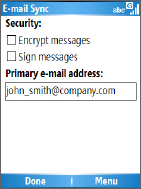
94 Exchanging Messages and Using Outlook
To exclude your email address when replying to all
When you reply to all the recipients of an email, your own email
address will also be added to the recipient list. You can customize
ActiveSync so that your email address will be excluded from the
recipient list.
1. On the Home screen, click Start > ActiveSync.
2. Click Menu > Options.
3. Select Email and click Settings.
4. Click Menu > Advanced.
5. In the Primary e-mail address text box, enter your email
address.
6. Click Done.
To add an attachment to an email message
1. In a new message, click Menu > Insert and then click Picture or
Voice Note.
2. Select the picture you want to attach or record a voice note.
To download attachments
• In an open message with an attachment, select the attachment.
The attachment is downloaded the next time you synchronize or
connect to your email server when sending and receiving email.
Exchanging Messages and Using Outlook 95
Download messages
The manner in which you download messages depends on the type of
account you have:
• To send and receive email for an Outlook E-mail account, begin
synchronization using ActiveSync. For more information, see “Set
up Outlook E-mail” in this chapter.
•
To send and receive email messages for an email
account that
you have with an Internet Service Provider (ISP) or that you
access using a VPN server connection (typically a work account),
download messages through a remote email server. For more
information, see “To download messages from the server” below.
• Text messages are automatically received when your phone is
turned on. When your phone is in flight mode, messages are held
by your service provider until you turn off flight mode.
To download messages from the server
To send and receive email messages for an email account that you
have with an Internet Service Provider (ISP) or that you access using
a VPN server connection (typically a work account), you first need to
connect to the Internet or your corporate network, depending on the
account.
1. On the Home screen, click Start > Messaging.
2. Select the email account.
3. Click Menu > Send/Receive. The messages on your phone and
email server are synchronized as follows: new messages are
downloaded to the phone Inbox folder, messages in the phone
Outbox folder are sent, and messages that have been deleted
from the server are removed from the phone Inbox folder.
Tip If you want to download the entire message, select the message and
click Menu > Download Message. The remainder of the message will
be downloaded the next time you send and receive email.
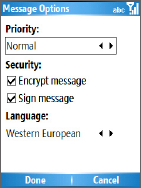
96 Exchanging Messages and Using Outlook
Individually sign and encrypt a message
Encrypting an Outlook email message protects the privacy of the
message by converting it from plain, readable text into cipher
(scrambled) text. Only the recipient who has the authorization key can
decipher the message.
Digitally signing a message applies your certificate with the
authorization key to the message. This proves to the recipient that the
message is from you and not from an imposter or a hacker, and that
the message has not been altered.
To digitally sign and encrypt a new message
1. In the message list, select Outlook E-mail.
2. Click New.
3. Click Menu > Message Options.
4. In the Security field, select the Encrypt message and Sign
message check boxes. Then click Done.
Verify the digital signature on a signed message you
receive
To verify a digital signature in a message that you receive, do the
following:
1. Open the Outlook email message that has been digitally signed.
2. At the top of the message, click View Signature Status.
Exchanging Messages and Using Outlook 97
3. Click Menu > Check Certificate.
4. To view the details of the certificate in the message, click Menu >
View Certificate.
Note There can be several reasons why a digital signature is not valid.
For example, the sender’s certificate may have expired, it may have
been revoked by the certificate authority or the server that verifies the
certificate is unavailable. Contact the sender to report the problem.
Manage folders
Each Messaging account has its own folder hierarchy with five default
Messaging folders: Inbox, Outbox, Deleted Items, Drafts and Sent
Items. The messages you receive and send through the account
are stored in these folders. You can also create additional folders
within each hierarchy. Folders for email accounts behave differently
depending on the type of email account you have.
If you set up an Outlook E-mail account to sync with Exchange Server
or a desktop PC, email messages in the Inbox folder in Outlook will
be synchronized automatically with your phone. You can select to
synchronize additional folders by designating them for synchronization.
The folders you create and the messages you move will then be
mirrored on the email server. For example, if you move two messages
from the Inbox folder to a folder named Family and you have
designated Family for synchronization, the server creates a copy of
the Family folder and copies the messages to that folder. You can then
read the messages while you are away from your PC. You can only
create and delete folders on devices when you are connected to an
Exchange email server.
As with an Outlook account, if you set up an account to send and
receive mail using an IMAP4 email server, all messages on the phone
are copies of the messages on the server. The folders you create
locally on the phone and the email messages you move to these
folders are mirrored on the email server. Moving a message on the
phone moves the copy on the server the next time you send and
receive email for that account. Therefore, messages are available to
you any time you connect to your email server, whether it is from your

98 Exchanging Messages and Using Outlook
phone or PC. This synchronization of folders occurs whenever you
connect to your email server, create new folders or rename/delete
folders when connected. You can also set different download options
for each folder.
If you set up an account to send/receive mail using a POP3 email
server, email messages you move to the Deleted Items folder on the
phone will break the link between the messages on the phone and their
copies on the email server. The next time you connect to send and
receive mail, the email server will detect the messages that are in the
Deleted Items folder on the phone and will delete those messages from
the email server. All other messages in other folders remain on both
the phone and the email server.
6.2 Using MMS Messages
Creating and sending Multimedia Message Service (MMS) messages
to your friends and family is fun and easy. You can include or capture
photos or video clips, include or record audio, add text, then send them
along with your MMS message.
To access MMS
Do any of the following:
• On the Home screen, click Start > Messaging > MMS.
• From the Pictures & Videos program, select a picture in My
Pictures and click Menu > Send. Select MMS as the messaging
account to send the picture along with the message.
• From the Camera program, capture a photo and then click the
Send icon ( ), select Send via MMS and click Send; or record
an MMS video clip and then click the Send icon ( ).
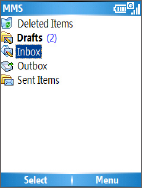
Exchanging Messages and Using Outlook 99
To access MMS message folders
• Click Start > Messaging > MMS, then click Menu > Folders.
MMS Message Folders
Edit MMS settings
When you send an MMS message, an SMS notification message
will first be sent to the recipient, while your MMS message will be
temporarily stored on an MMS server of your wireless service provider.
Similarly, when others send you an MMS message, the MMS message
will be stored on the MMS server, waiting for you to retrieve it. Hence,
your phone must be configured with the location of the MMS server for
you to be able to send and receive MMS messages on your phone.
When you purchase your phone, it is already preset with your wireless
service provider’s MMS server settings. If you accidentally lose the
preset settings or if you change to another wireless service provider,
follow the steps below to configure MMS settings.
To configure MMS settings
1. On the MMS main screen, click Menu > Options > Account
Options > MMS to open the Preferences screen.
2. Select or clear the provided check boxes according to your
needs. You can choose to keep track of your MMS messages,
retrieve messages immediately, accept or reject messages
and request a delivery or read receipt. You can also specify a
resolution for images you send and message delivery attempts.
3. On the Preferences screen, click Menu > MMSC Settings >
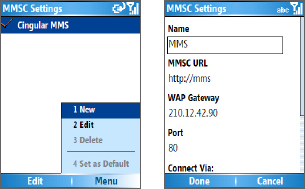
100 Exchanging Messages and Using Outlook
Edit to access Multimedia Messaging Service Center (MMSC)
settings.
4. Check if your phone is preset with MMS server settings.
If there are no preset settings, click Menu > New on the MMSC
Settings screen and enter the following information, which you
can get from your wireless service provider:
• Name. A descriptive name, such as your wireless service
provider name.
• MMSC URL. URL address of the MMS server.
• WAP Gateway. Location of the MMS server, which is usually
in the form of an IP address.
• Port. HTTP port number used for connecting to the MMS
server and for file transfer.
• Connect Via. Select The Internet from the list.
• Max. Sending Size. Select the maximum MMS message size
allowed by your wireless service provider.
• WAP Version. Select either WAP 1.2 or WAP 2.0, depending
on which one is being used by your wireless service provider.
5. Click Done.
The MMS server settings will then be added as an entry on the
MMS Configuration screen.
Exchanging Messages and Using Outlook 101
Note If you add several MMS service providers to the MMSC Settings screen,
you can choose one as your default MMS provider. Select the MMS
provider’s name in the list, then click Menu > Set as Default.
Create and send MMS messages
You can compose MMS messages in a combination of various slides,
where each slide can consist of a photo, audio/video clip and/or text.
Notes
• Please note that MMS is a charged service. In order to use MMS
successfully, this has to be provisioned on your mobile account. Please
contact the wireless service provider to have this provisioned as part of
your calling plan.
• Please ensure the size of the MMS is within the limits of the wireless
service provider if sending to another mobile phone user or sending to
an email address.
To start composing an MMS message
1. On the Home screen, click Start > Messaging > MMS > New.
2. In To, enter the recipient’s phone number or email address
directly, or press ENTER to choose a phone number or an email
address from Contacts. You can also click Menu > Recipients >
Add to add a new contact entry.
3. In Subject, enter a subject for your message.
4. Click Insert Picture/Video to select a photo or video clip from the
Select Media screen and insert it.
5. Enter text and insert audio clips by clicking the respective fields.
6. Click Send to send the message.
Note To send a copy of this message to others, access Cc and Bcc by
clicking Menu > Send Options. In these fields, enter the recipient's
phone number or email address or click Menu > Recipients > Add to
add from Contacts.
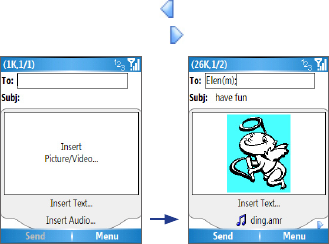
102 Exchanging Messages and Using Outlook
The following symbols act as shortcuts to some of the options on the
MMS Message screen.
• Press NAVIGATION left ( ) to go to the previous slide.
• Press NAVIGATION right ( ) to go to the next slide.
Composing an MMS Message
To create an MMS message from a template
• On the blank MMS message screen, click Menu > Template >
New from Template to compose a message using a predefined
template.
Note To save a message as a template, create a message or open an
existing message and click Menu > Template > Save as Template.
To insert a photo or video clip into an MMS message
You can add either a still image or a video clip to each individual slide
on the MMS message screen.
1.
Click Insert Picture/Video to insert a photo or video clip.
2. Select a picture or video clip on the Select Media screen. This
is the My Pictures folder where images and video clips are
displayed in thumbnail view. To navigate to any other folder
containing pictures or videos, click Menu > Change Folder.
3. Select a photo or video clip by using NAVIGATION and click
Select or Menu > Select to insert it.
Exchanging Messages and Using Outlook 103
On the Select Media screen, you can view the thumbnails in list
view, open an item to view it or delete an item by clicking Menu and
choosing the appropriate option. You can even discard this photo or
video clip by pressing BACK. To capture a new photo or video clip and
send it immediately with the message, click Menu > Capture Picture
or Menu > Capture Video. The newly captured photo or video clip is
automatically inserted into your message.
To add predefined text to an MMS message
You can instantly add text to any slide from a list of predefined words or
phrases, called Canned Text.
• On the MMS message screen, click Menu > Insert Object >
Canned Text and then click Select or Menu > Select to add a
text string from the Canned Text list.
Note To edit or delete a phrase on the Canned Text list, select a text string
and click Menu > Edit or Menu > Delete. To create and add a new
phrase to the list, click Menu > New.
To add an audio clip to an MMS message
You can add audio clips to your MMS messages. However, you can
add only one audio clip per slide.
1. Click Insert Audio to insert an audio clip.
Select an audio clip on the Select Audio screen.
Note By default, the audio clips listed on the Select Audio screen are from the
My Sounds folder. To navigate to any other folder containing audio clips,
click Menu > Change Folder.
2. Select an audio clip using NAVIGATION and click Select or
Menu > Select to insert it.
Note You can play and listen to the audio clip by clicking Menu > Play before
you insert it.
Otherwise, to record a new audio clip, click Menu > Capture
Audio. Then click Record to start recording and Stop to stop
recording. Click Play to listen to the new audio clip you captured,
then click Done.

104 Exchanging Messages and Using Outlook
The new audio clip is then added to your MMS message.
To set options for an MMS message
While composing an MMS message, you can set the following options
for the message by clicking Menu.
Option Allows you to
Recipients Specify the phone number or email address of the
recipient(s).
Insert Object Choose to insert a picture/video, audio or predefined text.
Capture Capture a photo, audio or video clip to be inserted into the
message.
Attachments Choose to attach a vCard, vCalendar or other file.
Remove Picture/
Remove Video
Delete a photo/video from the message.
Remove Audio Delete an audio clip from the message.
Remove Text Delete text from the message.
Slides Add and remove slides, view the next/previous slides and
specify the duration of slides.
Cancel Message Cancel the message and go back to the MMS Messaging
folders screen.
Background Choose a background color from the list.
Template Compose a message using a predefined template and save
a composed or existing message as a template.
Send Options Specify the message delivery time, validity, priority, class and
other settings for a message.
Preview
Message
Playback the contents of the MMS message before sending
it.
Send Message Send the message to the recipients.
View and reply to MMS messages
To receive MMS messages
• On any MMS message folder screen, click Menu > Send/
Receive.
By default, messages are automatically downloaded to your
phone.

Exchanging Messages and Using Outlook 105
To view an MMS message
You can view MMS messages in several ways.
• Press ENTER to view and play the message on your phone. Click
Pause or Menu > Stop to pause the playback of the message.
• Click Menu > Object View to see a list of files included in the
message. To open a file, select it and click Open. To save a file,
select it and click Save, Menu > Save Audio or Menu > Save
Photo.
• View each slide included in the message by clicking
Menu > Next
.
To reply to an MMS message
• Click Menu > Reply > Reply to reply to the sender of the
message, or click Menu > Reply > Reply All to reply to all
persons listed in the To and CC boxes of the message. Click
Menu > Reply > Forward to forward the message to someone
else.
6.3 Using Pocket MSN Messenger
Pocket MSN Messenger delivers the features of MSN Messenger to
your phone. With Pocket MSN Messenger, you can do the following:
• Send and receive instant messages.
• See which contacts are online or offline.
• Subscribe to status updates for selected contacts so you know
when they come online.
• Block contacts from seeing your status or sending you messages.
Before you can use MSN Messenger, your phone must be connected
to the Internet. For information about setting up an Internet connection,
see “Connecting to the Internet” in Chapter 5.
Important Note You must have either a Microsoft .NET Passport or a Hotmail
account to use MSN Messenger. If you have a Hotmail.com or
MSN.com email address, you already have a Passport. To get
a Passport account, go to http://www.passport.com. To get a
Hotmail account, go to http://www.hotmail.com.
106 Exchanging Messages and Using Outlook
To start MSN Messenger
1. On the Home screen, click Start > Pocket MSN.
2. Click MSN Messenger.
To sign in or out
• On the main MSN Messenger screen, click Sign In. Enter the
email address and password for your Passport or Hotmail
account and click Sign In.
Signing in may take several minutes, depending on the
connection speed.
• To sign out, click Menu > Sign Out.
To add or delete contacts
• To add a contact, click Menu > Add Contact and follow the
instructions on the screen.
• To delete a contact, select the contact and click Menu > Delete
Contact.
To send an instant message
1. Click the contact to whom you will send a message.
2. Enter your message in the text entry area at the bottom of the
screen and click Send.
Note To quickly add common phrases, click Menu > My Text and select a
phrase in the list.
To block or unblock contacts
• To block a contact from seeing your status and sending you
messages, select the contact and click Menu > Block.
• To unblock a contact, select the contact and click Menu >
Unblock.
To change your own Messenger status
1. Click your own name at the top of the screen.
Your current status is indicated by a bullet point in the displayed
list.
2. Select a status (such as Out To Lunch) from the list.
Exchanging Messages and Using Outlook 107
To change your display name
1. Click Menu > Options.
2. In My display name, enter the name you want to display to
others in MSN Messenger.
3. Click Done.
6.4 Using Calendar
Use Calendar to schedule appointments, including meetings and
other events. Your appointments for the day can be displayed on the
Home screen. If you use Outlook on your PC, you can synchronize
appointments between your phone and PC. You can also set Calendar
to remind you of appointments with a sound or flashing light, for
example.
To schedule an appointment
1. On the Home screen, click Start > Calendar.
2. Click Menu > New Appointment.
3. Enter information about the appointment.
4. To schedule an all-day event, in End time, select All day event.
5. Click Done.
Note All-day events do not occupy blocks of time in Calendar; instead, they
appear in banners at the top of the calendar.
To make an appointment recurring
1. On the Home screen, click Start > Calendar.
2. Click the appointment and click Edit.
3. Scroll to Occurs and click one of the recurrence options.
4. Click Done.
108 Exchanging Messages and Using Outlook
To view your schedule
You can view your schedule in three different views: Month, Week and
Agenda.
1. On the Home screen, click Start > Calendar.
2. Do one of the following:
• Click Menu > Month View.
• Click Menu > Week View.
• Click Menu > Go to Today, or click Menu > Agenda View
from Week or Month view.
To send a calendar appointment
You can send a calendar appointment to another phone over MMS.
1. On the Home screen, click Start > Calendar.
2. Select an appointment, then click Menu > Send as vCalendar.
3. Enter the recipient in the To line of the MMS message, then click
Send.
6.5 Using Contacts
Contacts is your address book and information storage for the people
and businesses you communicate with. Store phone numbers, email
addresses, home addresses and any other information that relates to a
contact, such as a birthday or an anniversary date. You can also add a
picture or assign a ring tone to a contact.
From the contact list, you can quickly communicate with people. Click
a contact in the list for a summary of contact information. From there,
you can call or send a message.
If you use Outlook on your PC, you can synchronize contacts between
your phone and your PC.
To create a new contact
1. On the Home screen, click Start > Contacts > New.
2. Enter information for the new contact.
3. Click Done.

Exchanging Messages and Using Outlook 109
Tips
• If someone who isn’t in your list of contacts calls you or sends you a
message, you can quickly create a contact from Call History or from
the message by clicking Menu > Save to Contacts.
• In the list of contact information, you’ll see where you can add a picture
or assign a ring tone to a contact.
To create a new contact on both your phone and SIM card
1. On the Home screen, click Start > Contacts > Menu > New SIM
Contact.
2. Enter information for the new contact and then click Done.
Tip To manage your SIM card contacts, use SIM Manager. To access SIM
Manager, click Start > Accessories > SIM Manager. SIM Manager
lets you copy contacts from Contacts to the SIM card, add SIM card
contents to Contacts, show SIM card storage information and more.
To view and edit a contact information
1. On the Home screen, click Start > Contacts.
2. Click the contact whose information you want to view.
3. To edit the information, click Menu > Edit.
4. When you’ve finished making changes, click Done.
To call a contact from the contact list
1. On the Home screen, click Start > Contacts.
2. Click the contact to call.
3. Press TALK ( )
.
The contact’s default phone number is dialed.
Tip To call a phone number other than the default, click the contact, scroll to
the number you want to dial and press TALK ( ).
To send an email to a contact
1. On the Home screen, click Start > Contacts.
2. Click the contact.
3. Click the email address.
4. Select the email account to use.
5. Enter a subject, compose your message and click Send.
110 Exchanging Messages and Using Outlook
To send a text message to a contact
1. On the Home screen, click Start > Contacts.
2. Click the contact and click Menu > Send Text Message.
3. Compose your message and click Send.
To find a contact
1. On the Home screen, click Start > Contacts.
2. If you are not in Name view, click Menu > View By > Name.
3. Do one of the following:
• Begin entering a name or phone number of the contact until
the contact is displayed. When you press a number, such
as 5, you find names that begin with J, K and L, as well as
phone numbers that start with 5. The next number you press
continues to narrow the search. For example, to find "John",
you would press 5, 6, 4 and then 6.
• Filter the list by categories. In the contact list, click Menu >
Filter. Then click a category you’ve assigned to a contact. To
show all contacts again, select All Contacts.
• Locate the contact by company. In the contact list, click Menu
> View By and click Company. Click the company to see the
contacts who work there.
To find a contact online
In addition to having contacts on your phone, you can also access
contact information from your organization’s Global Address List (GAL).
GAL is the address book that contains all user, group and distribution
list email addresses of your organization and it is stored on the
Exchange Server. By having direct online access to it from your phone,
it is quick and easy for you to plan a meeting and email a meeting
request immediately to anyone in your organization.
Access to the GAL is available if your organization is running Microsoft
Exchange Server 2003 SP2 and you have completed your first
synchronization with the Exchange Server.
1. Synchronize with Exchange Server if you have never done so.
2. Click Start > Contacts > Menu > View By > Name.
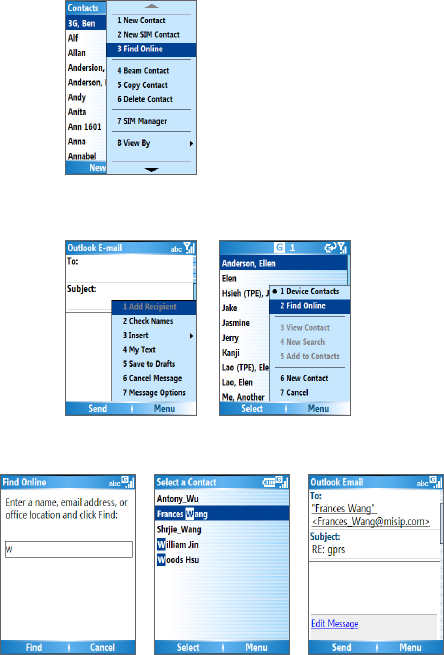
Exchanging Messages and Using Outlook 111
3. Do either of the following:
• In Contacts, click Menu > Find Online.
• In a new message, in the To box, click Menu > Add
Recipient> Menu > Find Online.
4. Enter the contact name and click Find. Select one contact in the
result list and click Select.
112 Exchanging Messages and Using Outlook
Notes
• Your phone must be set up with a data connection.
• You can search on the following information as long as that information
is included in your organization’s GAL: First name, Last name, Email
name, Display name, Email address or Office location.
To filter the contact list
Contacts that have categories assigned are displayed in the list when
you filter by category.
1. On the Home screen, click Start > Contacts.
2. Click Menu > Filter.
3. Click a category to filter.
To assign a ring tone to a contact
To easily identify who is calling you, you can assign a custom ring tone
to each contact.
1. On the Home screen, click Start > Contacts.
2. Click the contact you want to assign a ring tone to.
3. Click Menu > Edit.
4. Click Custom ring tone and select the ring tone you want.
5. Click Done.
To assign a picture to a contact
1. On the Home screen, click Start > Contacts.
2. Click the contact.
3. Click Menu > Edit.
4. Click Picture.
5. Click the picture you want to add.
To send a contact’s details
You can send a contact card to another phone over MMS.
1. On the Home screen, click Start > Contacts.
2. Select a contact, then click Menu > Send as vCard.
3. Enter the recipient’s name in the To line of the MMS message,
then click Send.
Exchanging Messages and Using Outlook 113
6.6 Using Tasks
Use Tasks to keep track of things you need to do. A task can occur
once or repeatedly (recurring). You can set reminders for your tasks
and you can organize them using categories. Your tasks are displayed
in a task list. Overdue tasks are displayed in red.
To create a task
1. On the Home screen, click Start > Tasks.
2. In the Enter new task here box, enter the task name and press
ENTER.
Notes
• You can synchronize information on your phone with your PC to keep
your task list up to date in both locations.
• If you create a new task with a reminder on your PC and then
synchronize tasks with your phone, the reminder will display at the time
that was set on your PC.
To delete a task
1. On the Home screen, click Start > Tasks.
2. Select the task and click Menu > Delete Task.
To locate a task
1. On the Home screen, click Start > Tasks.
2. In the task list, do one of the following:
• To sort the list, click Menu > Sort by and click a sort option.
• To filter the list by category, click Menu > Filter and click the
category you want to be displayed.
Note Categories appear only in tasks that are synchronized with your PC.
Tip To filter your tasks further, click Active Tasks or Completed Tasks.
To mark a task as completed
1. On the Home screen, click Start > Tasks.
2. Select the task and click Complete.
114 Exchanging Messages and Using Outlook
6.7 Using Voice Notes
Use Voice Notes to create short voice recordings. Voice notes are
included in the All Notes list and are named consecutively (Recording1,
Recording2, and so on).
To create a voice note
1. On the Home screen, click Start > Voice Notes.
2. Hold the phone’s microphone near your mouth.
3. Click Record and say your voice note.
4. Click Stop to stop recording a voice note.
To delete a voice note
1. On the Home screen, click Start > Voice Notes.
2. Select the voice note to delete.
3. Click Menu > Delete.
4. Click Yes.
Tip If you delete a voice note that has a default name, such as Recording1,
this name becomes available for a new voice note.
To listen to a voice note
1. On the Home screen, click Start > Voice Notes.
2. Select the voice note to play and press ENTER.
Tip To stop listening to the voice note, click Stop while the voice note is
playing.
To use a voice note as a ring tone
1. On the Home screen, click Start > Voice Notes.
2. Select the voice note and click Menu > Set As Ringtone.

7.1 Using Camera and Video Recorder
7.2 Using Pictures & Videos
7.3 Using Windows Media Player
7.4 Using MIDlet Manager
Chapter 7
Experiencing Multimedia

116 Experiencing Multimedia
7.1 Using Camera and Video Recorder
Taking photos and shooting video clips with audio are easy with your
phone’s built-in camera.
To open Camera or Video Recorder
Do any of the following:
• On the Home screen, click Start > Camera.
• On the Home screen, click Start > Video Recorder.
• Press the CAMERA button on your phone.
To exit Camera or Video Recorder
• Press END ( ).
To capture photos and video clips
You can do one of the following to capture photos and video clips:
• Click Capture on the Camera screen to take a photo. Also, click
Capture to start recording a video clip and then click Stop to end
the recording.
• Press the CAMERA button once to take a still image or to start
recording a video clip. When capturing video, you can also stop
video recording by pressing this button.
• Alternatively, you can press the ENTER button on the
NAVIGATION control to take a picture when you are capturing a
still image. Press this button to start recording a video clip; press
it again to stop recording.
Capture modes
The Camera program lets you capture pictures and video clips by using
various built-in modes. By default, Camera opens in the capture mode
you last accessed. The title bar displays the active capture mode.
To change the capture mode
• On the Camera screen, click Menu > Capture Mode and select a
capture mode from the list.
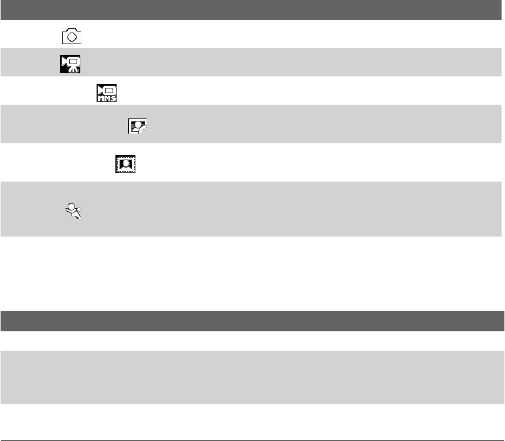
Experiencing Multimedia 117
The available capture modes are as follows:
Capture mode Function
Photo ( ) Captures standard still images.
Video ( )Captures video clips, with or without audio.
MMS Video ( ) Captures video clips suitable for sending via MMS.
Contacts Picture ( ) Captures a still image suitable for assigning as an
identification photo to a contact.
Picture Theme ( ) Captures still images and places them within
frames.
Sports ( )
Captures a sequence of still images (3 or 5 frames)
automatically for a short duration at a defined
frequency.
Using the above capture modes, the camera captures files in the
following formats:
Capture type Format
Still Image JPEG
Video Motion-JPEG AVI (.avi)
MPEG-4 (.mp4)
H.263 baseline (.3gp)
MMS Video MPEG-4 (.mp4)
H.263 baseline (.3gp)
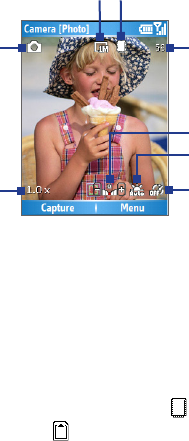
118 Experiencing Multimedia
Camera mode icons and indicators
The Camera [Photo] screen
2
1
3
6
4
5
7
8
1 Capture mode. Indicates the current capture mode.
2 Zoom-ratio. Indicates the current zoom ratio. Press
NAVIGATION up or down to increase or decrease the zoom level.
3 Resolution. Indicates the image or video size for the current
cpature mode. For the list of available resolutions, see the table
in “Use Zooming”.
4 Storage location. Indicates where the captured images and
video clips will be saved. The icon indicates the phone’s main
memory; the icon indicates the storage card.
5 Remaining number indicator. In Photo, Contacts Picture,
Picture Theme and Sports, this shows the remaining, available
shots of pictures that you can take based on current settings. In
Video and MMS Video modes, this shows the remaining duration
that can be recorded. While recording video, this shows the
recorded duration.
6 Exposure Value (EV). Allows you to adjust the exposure
value from -2 EV to +2 EV (increments of o.5) by pressing
NAVIGATION left or right.
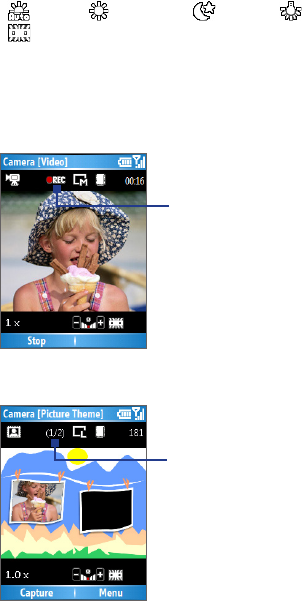
Experiencing Multimedia 119
7 White Balance. Indicates the current white balance setting.
: Auto; : Daylight; : Night; : Incandescent;
: Fluorescent.
8 Self-timer. Indicates the current Self-timer setting while capturing
images. Click Menu > Self-timer to select the Self-timer setting
(Off, 2 seconds or 10 seconds).
The Camera [Video] screen
The Recording Status indicator
shows a red, blinking indicator while
video recording is in progress.
Recording Status
The Camera [Picture Theme] screen
Template Status
The Template Status displays the
current and total number of photos
that can be taken using the selected
template.
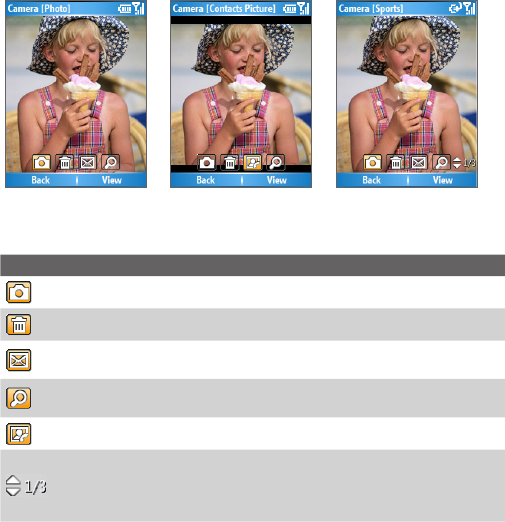
120 Experiencing Multimedia
The Review screen
After capturing an image or recording a video clip, the Review screen
appears allowing you to decide what to do with the image/video file.
Icons for Photo, Video,
MMS Video and Picture
Theme modes.
Icons for Contacts
Picture mode.
Icons for Sports mode.
Icon Function
Back. Click to go back to Camera screen.
Delete. Click to remove the captured image or video clip.
Send. Click to send the captured image or video clip to someone via
email or MMS.
View. Click to switch to the Pictures & Videos program to show the still
image or switch to Windows Media Player to play back the video clip.
Assign to Contacts. Click to associate the photo to a selected contact.
Browse. After you have taken photos in Sports mode, the total
number of consecutive shots is shown in the lower right corner of the
Review screen. Press NAVIGATION up or down to browse through the
sequence of photos.
Note If you capture a photo for the contact by using the Contacts Picture
mode, the picture size is 128 x 128 pixels, which will be dispalyed as a
full-screen image on the external screen. You can also assign or change
the photo for the contact by using the Pictures & Videos program (see
page 127) or through the Menu > Edit of Contacts (see page 109).
Experiencing Multimedia 121
Use Still Image capture modes
While using Still Image capture modes such as Photo, Contacts
Picture, Picture Theme or Sports, you can capture a single still image
by clicking Capture. You can also press the CAMERA button or the
ENTER button on the NAVIGATION control to capture the image. Still
images are captured and saved in the JPEG format.
While capturing an image in the Picture Theme mode, you can select
a preset template. To browse and choose from different templates,
click Menu > Template on the Camera screen to select a template.
Depending on the chosen template, one or more photos may need to
be taken for the template.
Use Video capture mode
While using the Video capture mode, you can click Capture, press the
ENTER button or press the CAMERA button on your phone to start
recording a video clip (with audio if desired). To stop recording, click
Stop or press either the ENTER button or the CAMERA button again.
Your phone displays the first frame of the captured video clip by default
on the Review screen.
Before you capture a video clip, click Menu > Advanced > Capture
Format on the Camera screen to specify the file format. You can set
the encoding format to Motion-JPEG AVI, MPEG-4 or H.263. You
can also specify the recording limit in terms of time or file size by
clicking Menu > Advanced > Recording Limit. To change the video
resolution, click Menu > Capture Settings > Resolution.
Use MMS Video capture mode
While using the MMS Video capture mode, click Capture on the
Camera screen to start capturing a video clip. You can also press the
ENTER button or the CAMERA button on your phone to start recording
a video clip (with audio if desired). To stop recording, click Stop or
press either the ENTER button or the CAMERA button again.
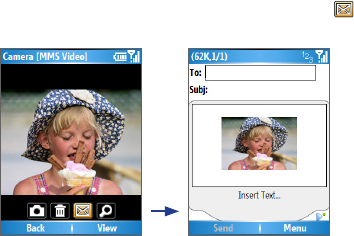
122 Experiencing Multimedia
The recording length of MMS video is fixed. The recording
automatically stops when the preset length is reached. However, you
can manually stop recording the video at any time. The time indicator
at the top-right corner of the screen indicates the time limit.
You can specify the encoding format to be either H.263 or MPEG-4
by clicking Menu > Advanced > Capture Format; however, the ideal
format for MMS is H.263 (3GP).
After you capture the video file, click the Send icon ( ) to send the
file through MMS.
Use zooming
Before capturing a still image or a video clip, you can first zoom in
to make the object in focus appear closer, and you can zoom out to
make the object appear further away. In all capture modes, press
NAVIGATION up on your phone to zoom in or NAVIGATION down to
zoom out. Alternatively, click Menu > Zoom to select a zoom ratio.
The camera zoom range for a picture or a video clip depends on the
capture mode and capture size. The following table is a summary.
Please note the capture sizes available for certain capture formats also
vary from one capture mode to another. The zoom range has been
calculated based on the following ratio:
• 1.0x = normal size (no zooming) • 2.0x = double enlargement
• 4.0x = four times enlargement • 8.0x = eight times enlargement

Experiencing Multimedia 123
Capture mode Resolution Zoom range
Video and
MMS Video
Small (128 x 96)
Medium (176 x 144), default
1.0x, 2.0x
1.0x, 2.0x
Small (160 x 120) 1.0x to 8.0x
Photo Medium (320 x 24) 1.0x to 4.0x
Large (640 x 480) 1.0x to 2.0x
1M (1280 x 1024), default 1.0x to 2.0x
Contacts Picture Small (128 x 128) 1.0x to 4.0x
Picture Theme Determined by the current
template
Depends on the size of the
currently loaded template
Sports Small (160 x 120)
Medium (320 x 24)
Large (640 x 480), default
1.0x, 2.0x, 4.0x, 8.0x
1.0x, 2.0x, 4.0x
1.0x, 2.0x
Use the Camera Menu
Clicking Menu on the Camera screen allows you to select various
capture modes and customize various settings for each mode. The
following table provides a list of the general options in the Menu.
Option Allows you to
Self-timer Select the Self-timer option for capturing images: Off,
2 seconds or 10 seconds. Selecting 2 seconds or 10
seconds delays the capturing by the specified time after you
press CAMERA or ENTER.
Template
This item appears when you use the Picture Theme mode,
allowing you to select a template.
Sports Settings
This item appears when you use the Sports mode. The Capture
Speed option decides the capturing speed by selecting Slow,
Moderate or Fast. The Snapshots provides 3 or 5 frames for
one shot.
Zoom
Zoom into or out from the object to be captured.
White Balance
Specify
the white balance setting such as Auto, Daylight,
Night, Incandescent and Fluorescent to suit the lighting
environment.
Capture
Settings
Choose the Resolution to use and set the storage location
(phone or storage card) for captured files. When capturing
images, you can also set the Quality and enable Time Stamp.
(Time Stamp only appears in Photo and Sports mode.)

124 Experiencing Multimedia
Option Allows you to
Capture Mode Switch between different capture modes such as Photo,
Video, Contacts Picture, and more. For details, see “Capture
modes” earlier in this chapter.
Effect
Choose a special effect such as Grayscale, Sepia or Cool to
apply to your photos or video clips.
Advanced Access more settings that let you customize the Camera
or Video Recorder functions. For details, see the following
section: “Advanced settings of the Camera Menu”.
Pictures &
Videos
Open the Pictures & Videos program.
Advanced settings of the Camera Menu
• Capture Format. Specify the file format for the image/video.
• Shutter Sound. Choose whether or not you want the camera to
make a shutter sound when you press the ENTER or CAMERA
button to take photos or record video clips.
• Review Duration. Set a time length for displaying the captured
image/video on the Review screen before automatically saving it
and returning to the live Camera screen. Select No Limit if you do
not want to impose a time limit.
• Flicker Adjustment. When taking indoor shots, flicker on the
camera screen may be caused by inconsistencies between the
vertical scan rate of the camera display and the flicker frequency
of fluorescent lighting. To reduce flicker, you can change the flicker
adjustment setting to Auto or to the proper frequency (50Hz or
60Hz) of the country where your device is being used.
• Full Screen (Still images only). Change the display of the
Camera screen by selecting On or Off.
• Record with Audio (Video and MMS Video only). Select On
to record audio with the captured video clips. This is selected by
default. If you select Off and then capture a video clip, it will have
no audio.
• Controls. Select Show or Hide to display or hide the indicators on
the Camera screen.
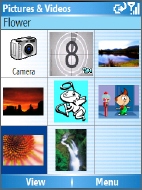
Experiencing Multimedia 125
• Prefix. Specify how to name captured images and video clips.
When Default is selected, the file name of each new captured file
is set to “IMAGE” or “VIDEO” followed by a sequential number, for
example: IMAGE_00001.jpg. You may also choose to name files
using either the current Date or Date & Time as the prefix.
• Counter. By default, the newly captured image or video files are
named with a prefix and some sequential numbers, such as 00001,
00002, and so on. To reset the numbering to “00001” for your
captured files, select Reset.
• Recording Limit (Video and MMS Video only). Specify the
maximum time or file size for recording.
• Template Folder (Picture Theme only). By default, templates
are stored in the \My Documents\Templates folder on the device’s
Main Memory. If you transferred some templates to the storage
card, set this option to Main + Card to specify that templates are
located in both the main memory and the storage card.
• Adjust. This option allows you to adjust the camera display
properties, such as Contrast, Saturation, Hue and Sharpness.
Press NAVIGATION up or down to select the property and press
NAVIGATION left or right to change the value.
7.2 Using Pictures & Videos
The Pictures & Videos program allows you
to view pictures and play GIF animation files
and video clips on your phone. You can also
view the pictures as a slide show, beam
them, send them via a messaging program,
edit them or set them as the background on
the Home Screen.

126 Experiencing Multimedia
To copy a picture or video clip to your phone
You can copy pictures from your PC and view them on your phone.
• Copy the pictures and video files from your PC or a storage card
to the My Pictures folder on your phone.
For more information about copying files from your PC to your phone,
see ActiveSync Help on your PC.
Note You can also copy pictures and video files from your PC to your phone
using a memory card. Insert the memory card into the memory card slot
on your computer, and then copy them from your PC to the folder you
created on the memory card.
To view pictures
1. On the Home screen, click Start > Pictures & Videos. The
images in the My Pictures folder appear as thumbnails by default.
2. Select a picture and click View.
If you cannot find a picture in the default My Pictures folder, click
Menu > Folders > My Device to go to other folders.
To play GIF animation files
1. On the Home screen, click Start > Pictures & Videos.
2. Select the GIF animation file and click View.
To play videos
1. On the Home screen, click Start > Pictures & Videos. Video files
appear as thumbnails with a icon.
2. Select a video and click Play to play it with the built-in Windows
Media Player.
To view slide shows
You can view your pictures as a slide show on your phone. Pictures are
shown in full-screen view with 5-second intervals between slides.
1. On the Home screen, click Start > Pictures & Videos.
2. Click Menu > Play Slide Show.
Experiencing Multimedia 127
Note You can specify how pictures are scaled to optimize their display in
a slide show. Click Menu > Options, select Slide Show and choose
either Portrait pictures or Landscape pictures. You can even set your
phone to play a screensaver on its monitor if your phone is connected to
the PC and idle for 2 minutes.
To start the camera from Pictures & Videos
• On the My Pictures folder, click Camera.
To delete a picture or video clip
• Select a picture or video clip on the Pictures & Videos screen and
click Menu > Delete. Click Yes to confirm the deletion.
To edit a picture
You can rotate, crop and adjust the brightness, color and contrast of
your pictures.
1. On the Home screen, click Start > Pictures & Videos.
2. Select the picture you want to edit and click View.
3. Click Menu > Edit and do any of the following:
• To rotate a picture 90 degrees, click Menu > Rotate.
• To crop a picture, click Menu > Crop. Then, drag the cursor
to position it on the first corner of the cropping area and click
Next. Select the second corner of the area to crop and click
Finish or click Previous to go back to the previous screen
and select again.
• To auto-adjust the brightness and contrast levels of a picture,
click Menu > Auto Correct.
4. On the Edit screen, click Menu > Save As to save the edited
picture with a new name or at a new location.
Note To undo an edit, click Menu > Undo. To cancel all unsaved edits you
made to the picture, click Menu > Cancel.
To set a picture as the Home screen background
1. On the Home screen, click Start > Pictures & Videos.
2. Select the picture you want to set as the background.
128 Experiencing Multimedia
3. Click View.
4. Click Menu > Use as Home Screen.
5. Select the display area and click Next.
6. Adjust the transparency. Select a higher percentage for a more
transparent picture or a lower percentage for a more opaque
picture.
7. Click Finish.
To send pictures and video clips via email
You can send pictures and video clips to other phones via email.
1. First, set up Messaging to send and receive messages.
2. On the Pictures & Videos screen, select the item you want to
send.
3. Click Menu > Send.
4. On the Messaging screen, select Outlook E-mail and click
Select.
A new message is created with the item attached.
5. Enter the recipient’s name and subject and click Send.
The message will be sent the next time you synchronize your
phone.
Note Pictures and video clips are saved automatically before they are sent.
To beam pictures
You can beam a picture to your friends or family by using bluetooth
technology.
1. On the Home screen, click Start > Pictures & Videos.
2. Select the picture you want to beam.
3. Click Menu > Beam.
4. Select the device to which you want to send the picture.
5. Click Beam.
Experiencing Multimedia 129
To assign pictures to contacts
You can assign a picture to a contact so that you can easily identify the
contact at any time.
1. On the Home screen, click Start > Pictures & Videos.
2. Select the picture you want to assign to a contact.
3. Click Menu > Save > Save to Contact.
4. Select the contact and click Select.
To customize picture options
1. On the Home screen, click Start > Pictures & Videos.
2. Select the picture for which you want to configure advanced
options.
3. Click Menu > Options.
4. Select General or Slide Show on the Options screen then press
ENTER.
The General option allows you to do the following:
• Decrease the picture size so that photos can be sent faster via
email.
• Set the direction to rotate a picture.
The Slide Show option allows you to do the following:
• Configure the view settings during slide shows.
• Activate screensaver.
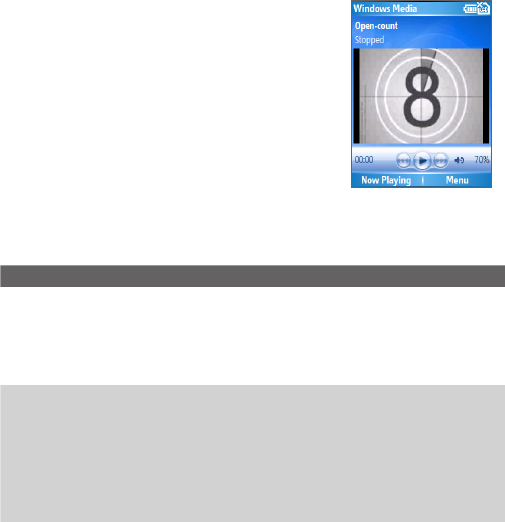
130 Experiencing Multimedia
7.3 Using Windows Media Player
You can use Microsoft® Windows Media™
Player Mobile for Smartphone to play digital
audio and video files that are stored on your
phone or on a network, such as on a website.
In this documentation, the version of
Windows Media Player for Windows-based
PCs is called the “desktop Player” and the
version for Smartphone is called the “device
Player.”
These are the following file formats that are supported by this version
of Windows Media Player Mobile.
Formats Supported File Extensions
Video
• Windows Media Video
• MPEG4 Simple Profile
• H.263
• Motion JPEG
.wmv, .asf
.mp4
.3gp
.avi
Audio
• Windows Media Audio
• MP3
• MIDI
• AMR Narrow Band
• AMR Wide Band
• AAC
.wma
.mp3
.mid, .midi, .rmi
.amr
.awb
.m4a

Experiencing Multimedia 131
About the controls
By default, these hardware buttons are assigned to Windows Media
Player Mobile functions.
To Press
Play or pause ENTER
Skip to a previous file NAVIGATION left
Skip to the next file NAVIGATION right
Increase the volume NAVIGATION up
Decrease the volume NAVIGATION down
Turn the sound on or off quickly (mute) #
Switch to full screen during video playback
0
Change rating *
Fast-forward a file NAVIGATION right (hold)
Rewind a file NAVIGATION left (hold)
About the screens and menus
Windows Media Player has three primary screens:
Playback screen. The default screen that displays the playback
controls (such as Play, Pause, Next, Previous and Volume) and the
video window. You can change the appearance of this screen by
choosing a different skin.
Now Playing screen. The screen that displays the Now Playing
playlist. This special playlist indicates the current file being played and
files that are queued up to play next.
Library screen. The screen that lets you quickly find your audio files,
video files and playlists. It contains categories such as My Music, My
Videos, My TV and My Playlists.
At the bottom of each screen is a Menu. The commands on this menu
vary, depending upon which screen you are viewing.

132 Experiencing Multimedia
Playback screen menu
When you are viewing the Playback screen, these options appear on
the Menu.
Option Allows you to
Library Display the Library screen so you can choose a file to play.
Play/Pause Start or pause playback.
Stop Stop playback.
Shuffle/Repeat
> Shuffle
Play the items in the Now Playing playlist in random order.
Shuffle/Repeat
> Repeat
Play the items in the Now Playing playlist repeatedly.
Full Screen When a video is playing, display it by using the entire screen.
Options Adjust various Windows Media Player Mobile options,
including network, skin and hardware button options.
Properties Display information about the currently playing file.
About Display information about Windows Media Player Mobile,
such as the version number.
Now Playing screen menu
When you are viewing the Now Playing screen, these options appear
on the Menu.
Option Allows you to
Library Display the Library screen so you can choose a file to play.
Move Up Move the selected item up in the playlist order.
Move Down
Move the selected item down in the playlist order.
Remove from
Playlist
Remove the selected item from the playlist.
Shuffle/Repeat
> Shuffle
Play the items in the Now Playing playlist in a random order.
Shuffle/Repeat
> Repeat
Play the items in the Now Playing playlist repeatedly.
Clear Now
Playing
Remove all items from the Now Playing playlist.
Error Details View error information about the selected item (an
exclamation mark appears before the item name if error
details are available).
Properties View information about the selected file.

Experiencing Multimedia 133
Library screen menu
When you are viewing the Library screen, these options appear on the
Menu.
Option Allows you to
Queue Up Add the selected item to the end of the current (Now Playing)
playlist.
Delete from
Library
Delete the selected item from the library.
Now Playing Display the Now Playing playlist.
Library >
library name
Switch between libraries, such as between My Device and
Storage Card.
Update Library Add new items to the library by searching your phone or
storage card.
Open File Find and play files that are stored on your phone or storage
card but that are not in the library.
Open URL Play a file on a network, such as the Internet.
Properties View information about the selected file.
About licenses and protected files
Some content (such as digital media files downloaded from the
Internet, CD tracks and videos) have associated licenses that protect
them from being unlawfully distributed or shared. Licenses are created
and managed by using digital rights management (DRM), which is the
technology for securing content and managing its access rights. Some
licenses may prevent you from playing files that have been copied to
your phone. Files that have licenses associated with them are called
“protected files.”
If you want to copy a protected file from your PC to your phone, use
the desktop Player to synchronize the file to your phone (instead of
dragging the file from a folder on your PC to a folder on your phone,
for example). This will ensure that the license is copied along with the
protected file. For more information about synchronizing files to your
phone and other mobile devices, see the desktop Player Help.
Note You can view the protection status for a file by checking its file
properties (Menu > Properties).
134 Experiencing Multimedia
Copy files to your phone
Use the Sync feature in the desktop version of Windows Media Player
to synchronize (copy) digital media files from your PC to your phone.
Using Sync ensures that protected files and album art (for skins) are
copied to your phone correctly.
To synchronize content to your phone automatically
1. On your PC, start Windows Media Player.
2. Insert a 32-MB or larger storage card into your phone, and then
connect your phone to your PC.
3. If you have not set up synchronization between your phone and
PC, the Device Setup Wizard opens on your PC.
4. In the wizard, click Automatic, select the Customize the
playlists that will be synchronized check box, and then select
the playlists that you want to synchronize.
5. Click Finish.
6. The files begin synchronizing to your phone. The next time
you connect your phone to your PC while the desktop version
of Windows Media Player is running, synchronization will start
automatically.
To synchronize and copy content manually to your phone
1. If you have not set up synchronization between your phone
and PC, follow steps 1 to 5 in “To synchronize content to your
phone automatically”, except that you should click Manual
synchronization.
2. To choose files to synchronize and copy to your device, do the
following:
• Click the Library tab.
• In the rightmost pane, click the drop-down list and select Sync
List.
• In the Playlist, which is the leftmost pane, select a desired
playlist.
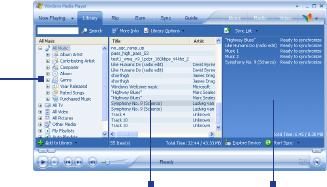
Experiencing Multimedia 135
Playlist
File List Sync List
• In the File List, which is the middle pane, multi-select desired
files and then drag them to the Sync List.
• Click the Start Sync button found at the bottom of the Sync
List.
Notes
• Always use the desktop version of Windows Media Player 10 to
synchronize (copy) files to your phone. For example, do not use
Windows Explorer to drag and drop files from your computer to your
phone.
• Always synchronize files to a storage card that is inserted into your
phone. Do not synchronize to a storage card that is inserted into a
storage card reader.
• Audio files copy faster if the desktop Player is configured to
automatically set the quality level for audio files copied to your phone.
For more information, see the desktop Player Help.
• The desktop version of Windows Media Player 10 is only available for
computers running Windows XP. If you are not running Windows XP
on your PC, use the Copy to CD or Device feature of Windows Media
Player 9 Series to copy your audio files and video files to your phone.
• The desktop version of Windows Media Player 9 Series is not as
full-featured as the desktop version of Windows Media Player 10. For
example, the desktop version of Windows Media Player 9 Series does
not support automatic synchronization, synchronization of playlists,
synchronization of album art or synchronization of TV shows recorded
by computers running Windows XP Media Center Edition.
• For more information about the Copy to CD or Device feature, start
the desktop version of Windows Media Player 9 Series, and then press
F1.
136 Experiencing Multimedia
Play media
To play media on your phone
Use the library to find and play songs, videos and playlists that are
stored on your phone or removable storage card.
1. If you are not on the Library screen, click Menu > Library.
2. If necessary, on the Library screen, click Menu > Library, and
then select the library that you want to use (for example, Storage
Card).
3. In most cases, Windows Media Player Mobile automatically
updates the library. However, you can manually update the library
to ensure that it contains new files that you recently copied to
your device or storage card. Tap Menu > Update Library to
manually update the library list.
4. Select a category (for example, My Music or My Playlists),
select the item that you want to play (such as a song, album or
artist name), and then click Play.
Note To play a file that is stored on your phone but is not in a library,
on the Library screen, click Menu > Open File. Select the item
that you want to play (such as a file or a folder) and click Play.
To play media on a network
Use the Open URL command to play a song or video that is stored on
the Internet or on a network server.
1. If you are not on the Library screen, click Menu > Library.
2. Click Menu > Open URL.
3. Do one of the following:
• In URL, enter a network address.
• In History, select a URL that you have previously used.
Note To play media on a network, your phone must be connected to a
network.

Experiencing Multimedia 137
Change Player appearance
You can change the appearance of the Playback screen by choosing a
new skin.
1. If you are not on the Playback screen, press BACK to display the
Playback screen.
2. Click Menu > Options > Skins.
3. To select a skin, press NAVIGATION left or right until you find the
skin that you want to use.
4. Click Done.
Notes
• To download new skins, see the WMplugins.com site at:
http://www.wmplugins.com
• After downloading a skin to your computer and unzipping it if
necessary, use ActiveSync to copy the .skn and .bmp files to your
phone (such as to the location, Smartphone\Program Files\Windows
Media Player, on the phone). To ensure that skins appear on the
Skins tab, do not store skin files in the Windows folder on your phone.
Troubleshooting
If you encounter any difficulty while using Windows Media Player
Mobile, a number of resources are available on the Web to help you
troubleshoot the issue, including a list of frequently asked questions
(FAQ).
For more information, see the Troubleshooting Windows Media Player
Mobile page at the Microsoft website (http://www.microsoft.com/
windows/windowsmedia/player/windowsmobile/troubleshooting.aspx).
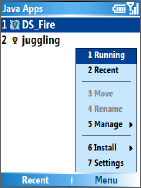
138 Experiencing Multimedia
7.4 Using MIDlet Manager
MIDlets are Java-based applications that can
run on mobile devices. Your phone supports
Java 2 Micro Edition (J2ME). The MIDlet
Manager allows you to download Java-based
applications, such as games and tools that
are specifically designed for mobile devices.
The Java MIDlet Manager gives you the
flexibility to install and manage additional
J2ME applications from the Internet.
MIDlet Manager
To install MIDlets from the Internet
1. On the Home screen, click Start > MIDlet Manager.
The Java Apps screen appears.
2. Click Menu > Install > Browse to open Internet Explorer Mobile.
3. Locate the MIDlet/MIDlet suite while connected to the Internet.
4. Select the MIDlet/MIDlet suite to download.
5. To start installing the MIDlet/MIDlet suite, click Yes.
6. Click Done to confirm the installation.
Notes
• You can cancel the installation at any time.
• Downloaded MIDlets will be automatically saved in the My
Documents folder.
To install MIDlets from a PC
You can install the MIDlets/MIDlet suites on your phone from a PC
using the USB sync cable or Bluetooth. MIDlets copied to your phone
using Bluetooth or email attachments are automatically saved in the
My Documents folder. However, you can copy the MIDlet file(s) from a
PC to any of the following temporary folders on your phone from where
MIDlet Manager can install them.
Experiencing Multimedia 139
• Device memory: ../Smartphone/My Documents/My MIDlets
• Storage card: ../Smartphone/Storage Card
Note If the My MIDlets folder does not exist in My Documents, you can create
one with the same folder name. However, a folder named Storage Card
automatically appears after you insert a storage card into your phone.
To install MIDlets from a local folder
1. On the Home screen, click Start > MIDlet Manager.
The Java Apps screen appears.
2. Click Menu > Install > Local to install the MIDlets currently
saved in the My MIDlets folder.
Click Recent to view the MIDlets or a MIDlet suite used recently
on your phone.
3. Select the MIDlet/MIDlet suite from the list by using the
NAVIGATION control.
4. Click Menu > Install.
5. Click Yes to install.
6. Click Done to confirm the installation.
Note To remove the MIDlet files from the default folder, click Menu > Delete.
To run MIDlets on your phone
1. On the Home screen, click Start > MIDlet Manager.
The Java Apps screen appears.
2. Select a MIDlet from the list by using the NAVIGATION control.
3. Press the ENTER button to run the MIDlet.
To view the MIDlets currently running
• On the MIDlet Manager Java Apps screen, click Menu >
Running.
Note To view the most recently used MIDlets, click Menu > Recent.
To stop running a MIDlet
1. On the Home screen, click Start > MIDlet Manager.
The Java Apps screen appears.
140 Experiencing Multimedia
2. Click Menu > Running.
3. Select a MIDlet on the Running MIDlets screen and click Menu >
Stop.
Note To stop all MIDlets currently running on your phone, click Menu > Stop
All.
Manage MIDlets
You can organize the MIDlets into groups and define custom groups.
You can also change the default display settings for a MIDlet.
To customize the display settings
1. On the Home screen, click Start > MIDlet Manager.
The Java Apps screen appears.
2. Click Menu > Settings.
3. On the Settings screen, select Display Options by using the
NAVIGATION control.
4. Press the ENTER button.
5. In View Options, choose to display the MIDlets either in groups
or all at once.
6. In Sort Options, choose to sort by Name or by Size.
7. Click Done.
To change the display name of a MIDlet
1. On the Home screen, click Start > MIDlet Manager.
The Java Apps screen appears.
2. Select a MIDlet by using the NAVIGATION control.
3. Click Menu > Rename.
4. Enter a new name for the MIDlet.
5. Click Done.
Note You cannot change the name of a MIDlet suite.
Experiencing Multimedia 141
To uninstall a MIDlet
Before you uninstall a MIDlet/MIDlet suite, make sure that it is not
running.
1. On the Java Apps screen, select the MIDlet/MIDlet suite by using
the NAVIGATION control.
2. Click Menu > Manage > Uninstall.
3. Click OK to confirm.
Note You cannot uninstall a single MIDlet from a MIDlet suite; you must
uninstall the complete MIDlet suite.
To check storage space
1. On the Home screen, click Start > MIDlet Manager.
2. Select a MIDlet by using the NAVIGATION control.
3. On the Java Apps screen, click Menu > Settings.
4. On the Settings screen, select System Info by using the
NAVIGATION control.
5. Press the ENTER button to see how much phone storage space
is used by the MIDlet.
6. Click OK.
To select a network type
1. On the Java Apps screen, click Menu > Settings.
2. Select Choose Network Type by using the NAVIGATION control.
3. Choose a network type from the list.
4. Click Select.
To configure MIDlet security
You can adjust security settings for each MIDlet/MIDlet suite.
1. On the Java Apps screen, select a MIDlet by using the
NAVIGATION control.
2. Click Menu > Manage > Security.
3. Configure the security options, such as Local Connectivity, App
Auto Run, Messaging, and so on.

142 Experiencing Multimedia
Please note that some features may not be available for all MIDlets/
MIDlet suites. A list of the security options that you can set for a
running MIDlet/MIDlet suite follows.
Security Option Description
Net Access Determines whether a MIDlet/MIDlet suite can
access the Internet.
Local Connectivity Enables a MIDlet/MIDlet suite to access services
such as Bluetooth.
App Auto Run Enables a MIDlet/MIDlet suite to run at specified
times or any time.
Messaging Determines whether a MIDlet/MIDlet suite can
send and/or receive text (SMS, Short Message
Service) messages.
Multimedia Recording Enables a MIDlet/MIDlet suite to record sounds
and images.
Error messages
The following is a list of error messages that you might receive while
managing and using MIDlets/MIDlet suites on your phone.
Error Message Description
Either RAM shortage or
insufficient space on the
file system.
There is insufficient memory on your phone.
Network out. There is no network connection available.
The jar size does not
match that specified in
the jad.
The installation information provided by the
MIDlet manufacturer is inaccurate.
The jar manifest does not
match the jad.
The installation information provided by the
MIDlet manufacturer is inaccurate.
Invalid Java application
descriptor (jad).
There is a problem with the installation file
provided by the MIDlet manufacturer.
Invalid Java archive (jar). There is a problem with the installation file
provided by the MIDlet manufacturer.
This Java application is
not compatible with this
device.
One or more features required by this MIDlet is
not available on your phone.

Chapter 8
Using Other Applications
8.1 Using ClearVue Suite
8.2 Using Speed Dial
144 Using Phone Features
8.1 Using ClearVue Suite
ClearVue Suite consists of four applications that let you view various
types of documents such as Word documents, Powerpoint presentation
files, Excel worksheets and Acrobat PDF files. The ClearVue Suite
consists of the following:
• ClearVue Presentation (displays PowerPoint files)
• ClearVue Worksheet (displays Excel files)
• ClearVue Document (displays Word files)
• ClearVue PDF (displays Acrobat/PDF files)
Note Not all fonts, colors, features and versions of the desktop versions of
PowerPoint, Word, Excel and Acrobat are supported, but ClearVue will
show a close approximation.
ClearVue Presentation
ClearVue Presentation is a complete PowerPoint viewer solution with
the ability to view native PowerPoint presentations. With ClearVue
Presentation, you will see the original presentation complete with
animations and transitions.
Note ClearVue Presentation only supports PowerPoint files created in
Office 97 or later versions.
To open a presentation file
1. Click File > Open and then locate the .ppt or .pps file.
2. Click Open.
To change the view
ClearVue Presentation lets you view your presentation file in 3 modes.
Click View and select either Normal, Slide Sorter or Notes.
• Normal. Displays a large single image of the current slide and
below it, small thumbnail images of other slides in the presentation.
• Slide Sorter. Slides will be displayed as small thumbnails.
• Notes. Lets you to view any slide notes that might have been
stored in the original presentation.

Using Phone Features 145
To change the zoom ratio of the view mode
• Click View > Scale.
Note This only applies to Normal and Notes view modes.
To set up your presentation show
1. Click View > Set Up Show.
2. In Advance Slides, select how you want to advance to the next
slide.
• Manually. Press NAVIGATION right to advance through the
slides.
• Use timings. Uses the timing information stored in the
PowerPoint file to determine when to display the next slide.
• Automatically. Automatically advances to the next slide
based on the time set in after __ secs.
Tip Click Loop continuously to loop the presentation. You need to
manually stop the presentation. To learn how to stop the presentation,
see “To view your presentation”.
3. Select the Orientation when viewing the presentation.
4. Click Black slide at end to add a blank slide after the last slide in
the presentation.
To set up a custom show
1. Click View > Custom Show.
2. In Show List, select the slide you want to edit and then click
Menu. In the Menu options, you can choose to either add, delete,
hide, move up or move down the slide.
Tip Click Reset to revert the presentation back to its original state.
To set up a custom show
• Click View > View Show.
Tip While viewing the presentation, press the key to open a menu
allowing you to go to the next/previous slide, go to a specific slide or
end the presentation.
146 Using Phone Features
ClearVue Worksheet
ClearVue Worksheet gives you the ability to view native Excel
worksheets. It also lets you view embedded charts and chart sheets as
well.
Notes
• ClearVue Worksheet only supports Excel files created in Office 97 or
later versions.
• Excel macros that might be in the original file will not run when loaded.
• Three-dimensional charts will be mapped into a two-dimensional
space.
• Worksheet does not display images selected as a background in an
AutoShape.
• Worksheet cannot open files that have been password protected using
the “Save Options” password setting in Microsoft Excel.
To open a worksheet file
1. Click File > Open and then locate the .xls file.
2. Click Open.
To change the zoom ratio
• Click View and select a magnification.
To view another sheet in your worksheet file
• Click View > Sheet and select the sheet you want to view.
ClearVue Document
ClearVue Document lets you view Word documents, complete with
tables, images, columns, bulleted lists, and more.
Note ClearVue Documemt only supports Word files created in Office 97 or
later versions.
To open a document file
1. Click File > Open and then locate the .doc or .rtf file.
2. Click Open.
Using Phone Features 147
After you open a file in ClearVue Document, it initially displays using
the default Page Width setting. This means that the page is sized to fit
within the available area of your Smartphone’s screen.
Click Zoom to change the magnification as desired, then scroll through
and view the document using the NAVIGATION buttons on your
Smartphone.
ClearVue PDF
ClearVue PDF lets you view PDF files on your Smartphone.
To open a PDF file
1. Click File > Open and then locate the .pdf file.
2. Click Open.
After you open a file in ClearVue PDF, it initially displays using the
default Page Width setting. This means that the page is sized to fit
within the available area of your Smartphone’s screen.
Click Zoom to change the magnification as desired, then scroll through
and view the PDF document using the NAVIGATION buttons on your
Smartphone.
148 Using Phone Features
8.2 Using Speed Dial
You can create speed dial entries for frequently-called numbers or
frequently-accessed items so you can dial a number or access an item
by pressing a single key.
To create a speed dial entry for a contact
1. On the Home screen, click Start > Contacts.
2. Select a contact.
3. Press ENTER to view the contact details.
4. Select the desired phone number and click Menu > Add to
Speed Dial.
5. Enter appropriate details in Name, Value and Keypad
assignment.
6. Click Done. To quit at any time during this process, click Menu >
Cancel.
Note Speed dials can be created only for numbers that are stored in
Contacts.
To create a speed dial entry for an item
1. On the Home screen, click Start and hoose (just highlight) the
desired item.
2. Click Menu > Add Speed Dial.
3. Enter details in Name, Value and Keypad assignment.
4. Click Done. To quit at any time during this process, click Menu >
Cancel.
Note The first speed dial location is generally reserved for your voice mail.
Speed Dial uses the next available location by default. If you want to
place a number in a location that is already used, the new number
replaces the existing number.
To retrieve a voice mail message
• On the Home screen, press and hold the 1 key on the keypad to
access your voice mailbox and follow the prompts to retrieve your
messages.
Using Phone Features 149
To make a call or launch a program using Speed Dial
• If you have assigned a speed dial (for example, the second
location) to a contact or a program in Speed Dial, you can
simply press and hold the 2 key on the Phone keypad to dial the
contact’s number or launch the program.
To delete a speed dial entry
1. On the Home screen, click Start > Speed Dial.
2. Select the desired entry and click Menu > Delete.
Create voice tags
With Speed Dial, you can also record a voice tag for a phone number,
email address or Web page address that is stored in Contacts.
Then, when you say the voice tag, your phone automatically dials
the associated phone number, opens an email message using the
associated address or goes to the associated Web page.
To create a voice tag for a phone number, email address or URL in
Contacts
1. On the Home screen, click Start > Contacts.
2. Select the desired contact and press ENTER to open the contact
card.
3. Select the item to which you want to assign a voice tag.
4. Click Menu > Add Voice Tag.
5. After a “beep” sound, begin recording the voice tag (preferably
one easy-to-recognize word).
6. When the voice tag is successfully recorded, the phone will play
back the voice tag. Click OK.
7. Enter appropriate details in Name, Value and Keypad
assignment. Click Done to save the new voice tag. To quit at any
time during this process, click Menu > Cancel.
150 Using Phone Features
To create a voice tag for a program
To create a voice tag for a program, (in this example, Calendar) do the
following:
1. On the Home screen, click Start and select (just highlight) the
Calendar item.
2. Click Menu > Add Voice Tag.
3. After a “beep” sound, say “Calendar.”
4. When the voice tag is successfully recorded, the phone will play
back the voice tag. Click OK.
5. Enter appropriate details in Name, Value and Keypad
assignment. Click Done to save the new voice tag. To quit at any
time during this process, click Menu > Cancel.
To edit, delete and play voice tags
• On the Home screen, click Start > Speed Dial.
• Select the desired voice tag from the list.
• Do any of the following:
• To change the voice tag, click Edit and make changes, then
click Done.
• To delete the voice tag, click Menu > Delete.
• To play back an existing voice tag at any time, click Menu >
Play Voice Tag.
To make a call or launch a program using the voice tag
1. On the Home screen, press and hold the VOLUME down button
on the left side of the phone for two seconds.
2. After a “beep” sound, say the recorded voice tag that you have
assigned to the phone number you want to call or the program
you want to launch. The phone plays back the voice tag and then
dials or launches the associated program.
Tip If the phone cannot recognize your voice tag, please try again and
speak clearly and reduce the surrounding noise.
A.1 Regulatory Notices
A.2 PC Requirement to Run ActiveSync 4.x
A.3 Specifications
Appendix
152 Appendix
A.1 Regulatory Notices
Agency identification numbers
For regulatory identification purposes, your product (Smartphone) is
assigned a model number of STAR100. The Battery Pack has been
assigned a model number of STAR160.
To ensure continued reliable and safe operation of your Smartphone,
use only the accessories listed in this document.
Note This product is intended to be used with a certified class 2 limited power
source, rated 5 volts DC, maximum 1A power supply unit.
Federal Communications Commission Notice
This device complies with part 15 of the FCC Rules. Operation is
subject to the following two conditions: (1) This device may not cause
harmful interference, and (2) this device must accept any interference
received, including interference that may cause undesired operation.
This equipment has been tested and found to comply with the limits for
a Class B digital device, pursuant to Part 15 of the FCC Rules. These
limits are designed to provide reasonable protection against harmful
interference in a residential installation. This equipment generates,
uses, and can radiate radio frequency energy and, if not installed
and used in accordance with the instructions, may cause harmful
interference to radio communications. However, there is no guarantee
that interference will not occur in a particular installation. If this
equipment does cause harm-ful interference to radio or TV reception,
which can be determined by turning the equipment on and off, the user
is encouraged to try to correct the interference by one or more of the
following measures:
• Reorient or relocate the receiving antenna.
• Increase the separation between the equipment and receiver.
• Connect the equipment into an outlet on a circuit different from
that to which the receiver is connected.
• Consult the dealer or an experienced radio or television
technician for help.
Appendix 153
• The FCC requires the user to be notified that any changes or
modifications made to the device that are not expressly approved
by High Tech Computer Corporation may void the user’s authority
to operate the equipment.
Important safety information
Retain and follow all product safety and operating instructions. Observe
all warnings on the product and in the operating instructions.
To reduce the risk of bodily injury, electric shock, fire, and damage to
the equipment, observe the following precautions.
Safety precautions for RF exposure
Use only original manufacturer-approved accessories, or accessories
that do not contain any metal and position the handset a minumum
of 1.5cm from the body.
Use of non-original manufacturer-approved accessories may violate
your local RF exposure guidelines and should be avoided.
Heed service markings
Except as explained elsewhere in the Operating or Service
documentation, do not service any product yourself. Service needed
on components inside these compartments should be done by an
authorized service technician or provider.
Damage requiring service
Unplug the product from the electrical outlet and refer servicing to
an authorized service technician or provider under the following
conditions:
• Liquid has been spilled or an object has fallen into the product.
• The product has been exposed to rain or water.
• The product has been dropped or damaged.
• There are noticeable signs of overheating.
• The product does not operate normally when you follow the
operating instructions.
Avoid hot areas
The product should be placed away from heat sources such as
radiators, heat registers, stoves, or other products (including amplifiers)
that produce heat.
154 Appendix
Avoid wet areas
Never use the product in a wet location.
Avoid pushing objects into product
Never push objects of any kind into cabinet slots or other openings
in the product. Slots and openings are provided for ventilation. These
openings must not be blocked or covered.
Mounting accessories
Do not use the product on an unstable table, cart, stand, tripod, or
bracket. Any mounting of the product should follow the manufacturer’s
instructions, and should use a mounting accessory recommended by
the manufacturer. Do not place the product with an unstable base.
Use product with approved equipment
This product should be used only with personal computers and options
identified as suitable for use with your equipment.
Adjust the volume
Turn down the volume before using headphones or other audio
devices.
Cleaning
Unplug the product from the wall outlet before cleaning. Do not use
liquid cleaners or aerosol cleaners. Use a slightly damp cloth for
cleaning, but NEVER use water to clean an LCD screen.
Safety precautions for power supply unit
Use the correct external power source
A product should be operated only from the type of power source
indicated on the electrical ratings label. If you are not sure of the type
of power source required, consult your authorized service provider or
local power company. For a product that operates from battery power
or other sources, refer to the operating instructions that are included
with the product. Handle battery packs carefully: This product
contains a Lithium-Ion battery. There is a risk of fire and burns if the
battery pack is handled improperly. Do not attempt to open or service
the battery pack. Do not disassemble, crush, puncture, short external
Appendix 155
contacts or circuits, dispose of in fire or water, or expose a battery pack
to temperatures higher than 140° F (60° C).
Exposure to radio frequency (RF) signals
Your wireless phone is a radio transmitter and receiver. It is designed
and manufactured not to exceed the emission limits for exposure to
radio frequency (RF) energy. These limits are part of comprehensive
guidelines and establish permitted levels of RF energy for the
general population. The guidelines are based on the safety standards
previously set by international standards bodies:
• American National Standards Institute (ANSI) IEEE. C95.1-1992
• National Council on Radiation Protection and Measurement
(NCRP). Report 86. 1986
• International Commission on Non-Ionizing Radiation Protection
(ICNIRP) 1996
•
Ministry of Health (Canada), Safety Code 6. The standards
include
a substantial safety margin designed to assure the safety of all
persons, regardless of age and health.
The exposure standard for wireless mobile phones employs a unit of
measurement known as the Specific Absorption Rate, or SAR.
The standard incorporates a substantial margin of safety to give
additional protection for the public and to account for any variations
in usage. Normal conditions only ensure the radiative performance
and safety of the interference. As with other mobile radio transmitting
equipment, users are advised that for satisfactory operation of the
equipment and for the safety of personnel, it is recommended that no
part of the human body be allowed to come too close to the antenna
during operation of the equipment.
SAR Information
• 0.825 mW/g @ 1g (FCC)
156 Appendix
Telecommunications & Internet Association (TIA)
safety information
Pacemakers
The Health Industry Manufacturers Association recommends that a
minimum separation of six inches be maintained between a handheld
wireless phone and a pacemaker to avoid potential interference
with the pacemaker. These recommendations are consistent with
the independent research by and recommendations of Wireless
Technology Research. Persons with pacemakers:
• Should ALWAYS keep the phone more than six inches from their
pacemaker when the phone is turned ON.
• Should not carry the phone in a breast pocket.
• Should use the ear opposite the pacemaker to minimize the
potential for interference. If you have any reason to suspect that
interference is taking place, turn your phone OFF immediately.
Hearing Aids
Some digital wireless phones may interfere with some hearing aids. In
the event of such interference, you may want to consult your service
provider, or call the customer service line to discuss alternatives.
Other Medical Devices
If you use any other personal medical device, consult the manufacturer
of your device to determine if they are adequately shielded from
external RF energy. Your physician may be able to assist you in
obtaining this information.
Turn your phone OFF in health care facilities when any regulations
posted in these areas instruct you to do so. Hospitals or health care
facilities may be using equipment that could be sensitive to external
RF energy.

Appendix 157
Safety Precautions
SAFETY IN AIRCRAFT: This product can cause interference to an aircraft's
navigation system and network. In most countries it is against the law to use
this product on board an airplane.
ENVIRONMENTAL SAFETY: Do not use this product in gas stations, fuel
stores, chemical plants and locations containing explosives.
ROAD SAFETY: Vehicle drivers in motion are not permitted to use handheld
telephony services, except in emergency. In some countries, using hands-free
devices as an alternative is allowed.
MEDICAL EQUIPMENT SAFETY: This product may cause medical equipment
malfunction. In most hospitals or medical centers use of this product is
forbidden.
Other tips and cautions
• Avoid using your phone near metal structures (for example, the
steel frame of a building).
• Avoid using your phone near strong electromagnetic sources,
such as microwave ovens, sound speakers, TV and radio.
• Avoid using your phone after a dramatic change in temperature.
158 Appendix
A.2 PC Requirement to Run ActiveSync 4.x
To connect your device to the PC, you must have Microsoft®
ActiveSync® installed on your PC. ActiveSync 4.x is included in the
Installation CD, which is compatible with the following operating
systems and applications:
• Microsoft® Windows® 2000 Service Pack 4
• Microsoft® Windows® Server 2003 Service Pack 1
• Microsoft® Windows® Server 2003 IA64 Edition Service Pack 1
• Microsoft® Windows® Server 2003 x64 Edition Service Pack 1
• Microsoft® Windows® XP Professional Service Packs 1 and 2
• Microsoft® Windows® XP Home Service Packs 1 and 2
• Microsoft® Windows® XP Tablet PC Edition 2005
• Microsoft® Windows® XP Media Center Edition 2005
• Microsoft® Windows® XP Professional x64 Edition
• Microsoft® Outlook® 98, Microsoft® Outlook® 2000 and Microsoft® Outlook®
XP, and Microsoft® Outlook® 2003 messaging and collaboration clients
• Microsoft® Office 97, excluding Outlook
• Microsoft® Office 2000
• Microsoft® Office XP
• Microsoft® Office 2003
• Microsoft® Internet Explorer 4.01 or later (required)
• Microsoft® Systems Management Server 2.0

Appendix 159
A.3 Specifications
System information
Processor TI OMAP 850
Memory • ROM: 128 MB (Standard)
• RAM: 64 MB (Standard)
Operating system Microsoft Windows MobileTM Version 5.0 for
Smartphone
Display
Main screen 2.2” TFT-LCD, 320 x 240 at 65K colors
External screen 1.2” TFT-LCD, 128 x 128 at 65K colors
GSM/GPRS/EDGE Quad-band module
GSM 850 824 – 849, 869 – 894MHz
GSM 900 880 – 915, 925 – 960 MHz
GSM 1800 1710 – 1785, 1805 – 1880 MHz
GSM 1900 1850 – 1910, 1930 – 1990 MHz
Camera module
Type 1.3 Megapixel Color CMOS
Resolution • SXGA: 1280 x 1024
• VGA: 640 x 480
• QVGA: 320 x 240
• QQVGA: 160 x120
Connection
I/O port 12-pin connector for signals (for audio, USB and
power)
Bluetooth V1.2, Class 2 transmit power

160 Appendix
Audio
Microphone/speaker
Built-in microphone and 3-in-1 speaker
Headphone AAC/AMR/WMA/WAV/MP3 codec
Physical
Dimension 98.5mm(L) x 51.4mm(W) x 15.8mm(T)
Weight 99g with battery pack
Controls and lights
Navigation 5-way navigation pad/ENTER button
Buttons • Three Music keys: Play/Pause, FF, and RW
• Two program buttons: Comm Manager (left side)
and CAMERA (right side)
• Volume Up button (left upper side)
- Quick press to adjust volume up
- Long press to launch Voice Record
• Volume Down button (left lower side)
- Quick press to adjust volume down
- Long press to launch Voice Command
• Two SOFT KEYs
• HOME button
• BACK button
• TALK button (start call/answer call)
• END button (end call/power on and off)
• 12-button dialing keypad
Lights • Event notification
• Charge status
• GSM/GPRS signals
• Bluetooth connection

Appendix 161
Expansion slot
SD slot Micro SD memory card
Power supply
Battery 1100mAh (typical) Lithium-Ion removable,
rechargeable battery
• Talk time: 3.6 – 7 hours
• Standby time: 146 – 220 hours
AC adapter • AC input/frequency: 100 – 240 VAC, 50/60Hz
• Rated output: 5VDC, 1A (typical)
162 Appendix
Index
164 Index
A
A2DP (Advanced Audio Distribution
Profile) 83
Accessibility settings
- confirmation time out 56
- in-call alert volume 56
- multipress time out 56
- system font size 56
ActiveSync 22
- install and set up 40
- overview 40
- synchronize 43
Add and remove programs 58
Alarm 55
Alarm settings 53
Alerts 53
Answer/end call 34
Answer Mode 52
Attachments 94
B
Backlight time out 56
Back up files 61
Battery 28
- battery management 56
- check battery power 28
- optimize power performance
28
Beam
- via Bluetooth 84
Bluetooth
- beaming 84
- Bluetooth modem 86
- discoverable 79
- handsfree headset 83
- modes 79
- overview 79
- partnerships 80
- stereo headset 83
- synchronize 47
C
Calculator 22
Calendar 22, 107
Call History 22
Camera 22
- camera button 116
- icons and indicators 118
- main menu 123
- zoom 122
Capture formats 117
Capture modes 117
ClearVue Suite 144
- ClearVue Document 146
- ClearVue PDF 147
- ClearVue Presentation 144
- ClearVue Worksheet 146
Clear Storage 22
Close running programs 60
Comm Manager 22, 78
Compose
- email/SMS message 93
- MMS message 101
- MMS message from template
102
Conference call 35
Confirmation time out 56
Connect notebook to Internet using
phone as modem 76
Connect phone to Internet
- dial-up to ISP 69
Index 165
- GPRS 68
Connect phone to private network
70
Contacts 22, 108
Contacts picture (capture mode)
117, 121
Cookies (Internet Explorer) 74
Copy
- files between phone and PC 61
- media files from PC to phone
134
- pictures and videos 126
- sound file to phone 55
Currency setting 53
Customize Home screen 52
Customize picture options 129
D
Date setting 53
Default view (Web page) 72
Delete pictures and videos 127
Desktop view (Web page) 72
Dial-up connection 69
Digitally sign messages 49, 96
Digital Rights Management (DRM)
133
Digital signature
- verify 96
Direct Push 46
Discoverable (Bluetooth) 80
Display time out 57
Download Agent 22
Download messages 95
E
Edit picture 127
Email
- attachments 94
- Outlook 90
- overview 90
- POP3/IMAP4 91
- security 49, 96
- send and receive 93
Emergency call 36
Encrypt messages 49, 96
Enter text and numbers 25
Error reporting 57
Event notification 53
Exchange Server
- schedule synchronization 46
- synchronize 45
Exclude email address when
replying to all 94
external screen 57
F
Favorites (Internet Explorer) 73
File Explorer 62
Find contacts online 110
Font size (display) 56
Full-screen mode (Internet Explorer)
73
G
Games 22
GIF animation 126
Global Address List (GAL) 110
GPRS 68
166 Index
H
Hide pictures on Web page 73
History (Internet Explorer) 74
Home screen 20
- change background 127
- customize 52
- overview 52
I
IMAP4 91
In-call alert volume 56
Insert pause in dialing sequence
36, 37
Insert SIM Card 18
Install Micro SD Card 19
Install MIDlets
- from Internet 138
- from PC 138
- locally 139
International call 36
Internet 68
Internet Explorer 23
Internet Explorer Mobile 72
K
Keypad
- lock 65
- sound 54
L
Language/locale setting 53
Launch camera from Pictures &
Videos 127
LED indicator lights 16
Licensed and protected media 133
Light sensor (keypad) 57
Lock
- keypad 65
- phone 65
M
Make call
- from Call History 33
- from Contacts 32
- from Home Screen 31
- from Speed Dial 33
- SIM Manager 33
Manage low battery 28
Media synchronization settings 48
Memory 60
Message folders 97
Messaging 23, 90
MIDlet Manager 23, 138
MMS
- access MMS 98
- add audio 103
- add canned text 103
- add photo/video 102
- create and send 101
- menu options 104
- MMS settings 99
- view and reply 104
MMS video (capture mode) 117,
121
Modem
- Bluetooth modem 86
MSN Messenger 105
Multipress mode 25
Multipress time out 56
Mute call 35
Index 167
N
Number format 53
Numeric mode 26
O
One column view (Web page) 72
Operating system version 57
Outlook E-mail 90
Owner information 55
P
Parts and accessories 12
Pause in dialing sequence 36, 37
Personal information 55
Phone program 29
Phone specification 57
Photo (capture mode) 117, 121
Pictures
- assign to contact 112
- assign to contacts 129
- hide or show on Web page 73
- set as Home screen back-
ground 127
Pictures & Videos 23, 125
Picture theme (capture mode) 117,
121
PIN 30, 64
Play media 136
Pocket MSN 23, 105
POP3 91
Power management 56
Profile 53
Programs 21
- ActiveSync 22, 40
- Calculator 22
- Calendar 22, 107
- Call History 22
- Camera 22, 116
- ClearVue Document 22
- ClearVue PDF 22
- ClearVue PPT 22
- ClearVue Worksheet 22
- Clear Storage 22
- Comm Manager 22
- Contacts 22, 108
- Download Agent 22
- Games 22
- Internet Explorer 23, 72
- Messaging 23, 90
- MIDlet Manager 23, 138
- Phone 29
- Pictures & Videos 23, 125
- Pocket MSN 23, 105
- SIM Tool Kit 23
- Speed Dial 23
- Tasks 23, 113
- Task Manager 23, 60
- Video Recorder 23, 116
- Voice Notes 23, 114
- Windows Media Player Mobile
23, 130
Put call on hold 34
Q
Quick List 24
R
Receive
- call 34
- email/SMS message 93
168 Index
- MMS message 104
Regional settings 53
Reply
- email/SMS message 94
- MMS message 105
Reset phone 66
Restart phone 66
Review screen 120
Ring tone 30, 112, 114
Run MIDlets 139
S
Secure/Multipurpose Internet Mail
Extension (S/MIME) 49
Security
- email 49, 96
- Internet 74
Send
- contact’s details (vCard) 112
- email/SMS message 93
- instant message (MSN) 106
- MMS message 101
- pictures/videos via email 128
Settings 23
Set up Home screen 52
SIM Manager 23, 109
SIM Tool Kit 37
SMS 90, 93
Sounds 53
Speakerphone 35
Speed Dial 23, 33
Sport (capture mode) 117, 121
Start menu 24
Status indicators 21
Still image capture modes 121
Stop programs 60
Swap/switch calls 35
Synchronize
- information types 44
- music and video 48
- Outlook information with Ex-
change Server 45
- Outlook information with the
computer 43
- schedule synchronization with
Exchange Server 46
- start/stop synchronization 43
- storage card 48
- via Bluetooth 47
Sync Setup Wizard 40
System font size 56
T
T9 mode 26
Tasks 23, 113
Task Manager 23, 60
Temporary files (Internet Explorer)
74
Text messages (SMS) 90, 93
Text size (Web page) 72
Time setting 53
U
USB modem 74
V
vCard 112
Verify digital signature 96
Video (capture mode) 117, 121
Video Recorder 23, 116
View
Index 169
- photo slide show 126
- pictures 126
Voice Notes 23, 114
Voice tag
- create voice tag for phone
number, email address or URL
in Contacts 149
- create voice tag for program
150
- edit, delete and play voice tags
150
W
Web browser 72
Web page display options 72
Windows Media Player
- file formats 130
- menus 131
- synchronize 48
- troubleshooting 137
Windows Media Player Mobile 23
Windows Mobile software version
57
Wireless Modem 23, 74
Z
Zoom 122

WEEE Notice
The Directive on Waste Electrical and Electronic Equipment (WEEE), which
entered into force as European law on 13th February 2003, resulted in a
major change in the treatment of electrical equipment at end-of-life.
The purpose of this Directive is, as a first priority, the prevention of WEEE,
and in addition, to promote the reuse, recycling and other forms of recovery
of such wastes so as to reduce disposal.
The WEEE logo on the product or on its box indicates that this product
must not be disposed of or dumped with your other household waste. You
are liable to dispose of all your electronic or electrical waste equipment
by relocating over to the specified collection point for recycling of such
hazardous waste. Isolated collection and proper recovery of your electronic
and electrical waste equipment at the time of disposal will allow us to help
conserving natural resources. Moreover, proper recycling of the electronic
and electrical waste equipment will ensure safety of human health and
environment. For more information about electronic and electrical waste
equipment disposal, recovery, and collection points, please contact your
local city centre, household waste disposal service, shop from where you
purchased the equipment, or manufacturer of the equipment.